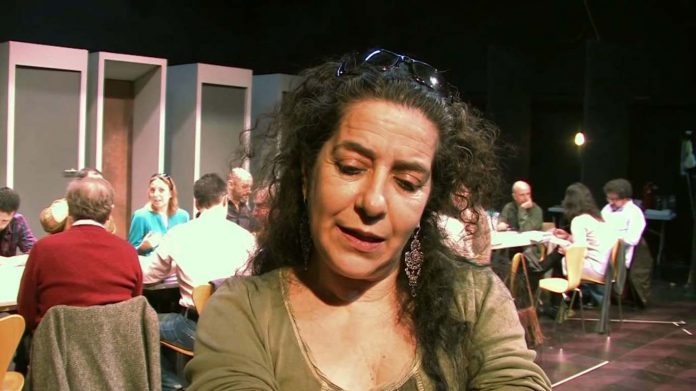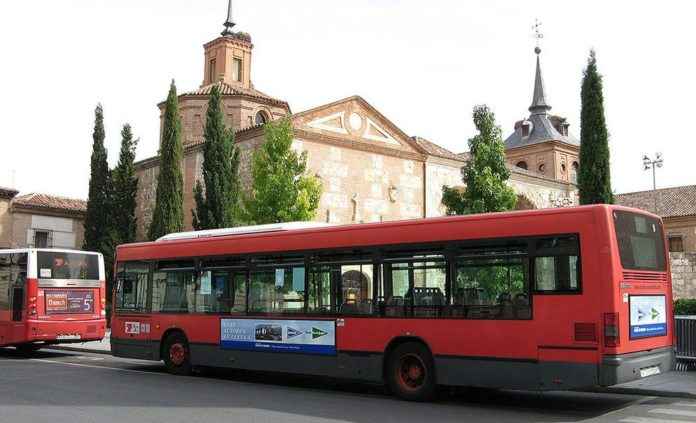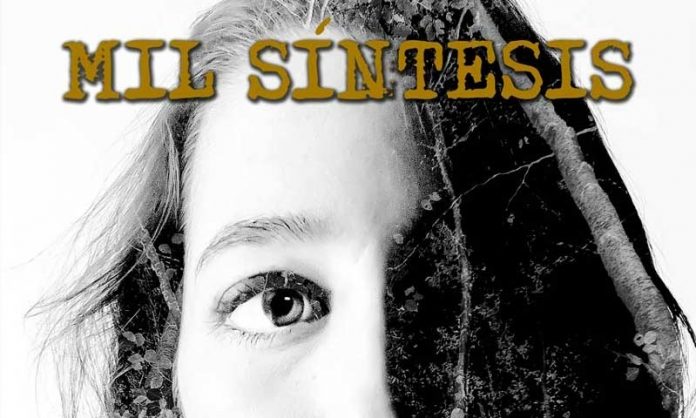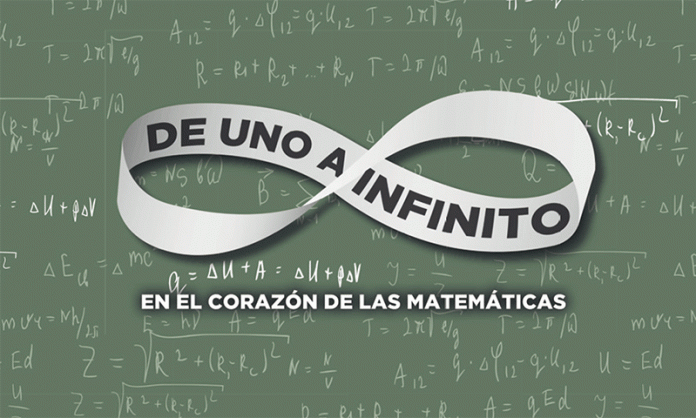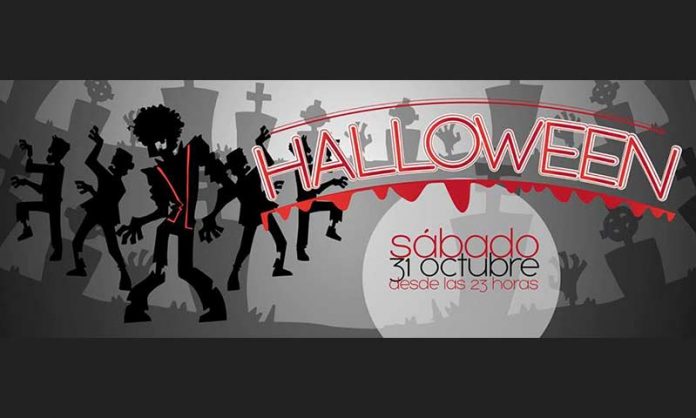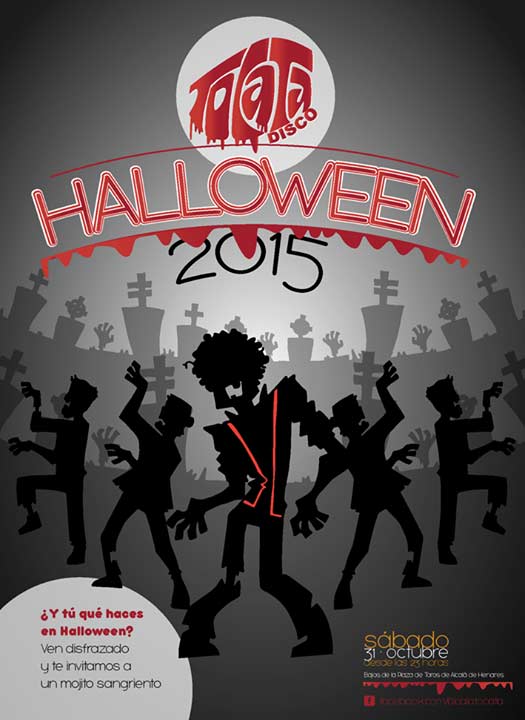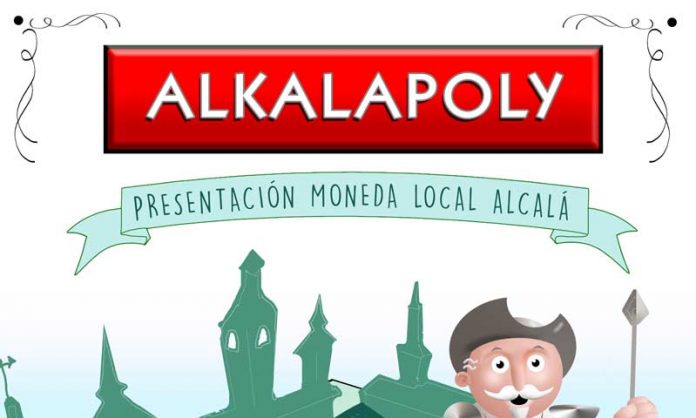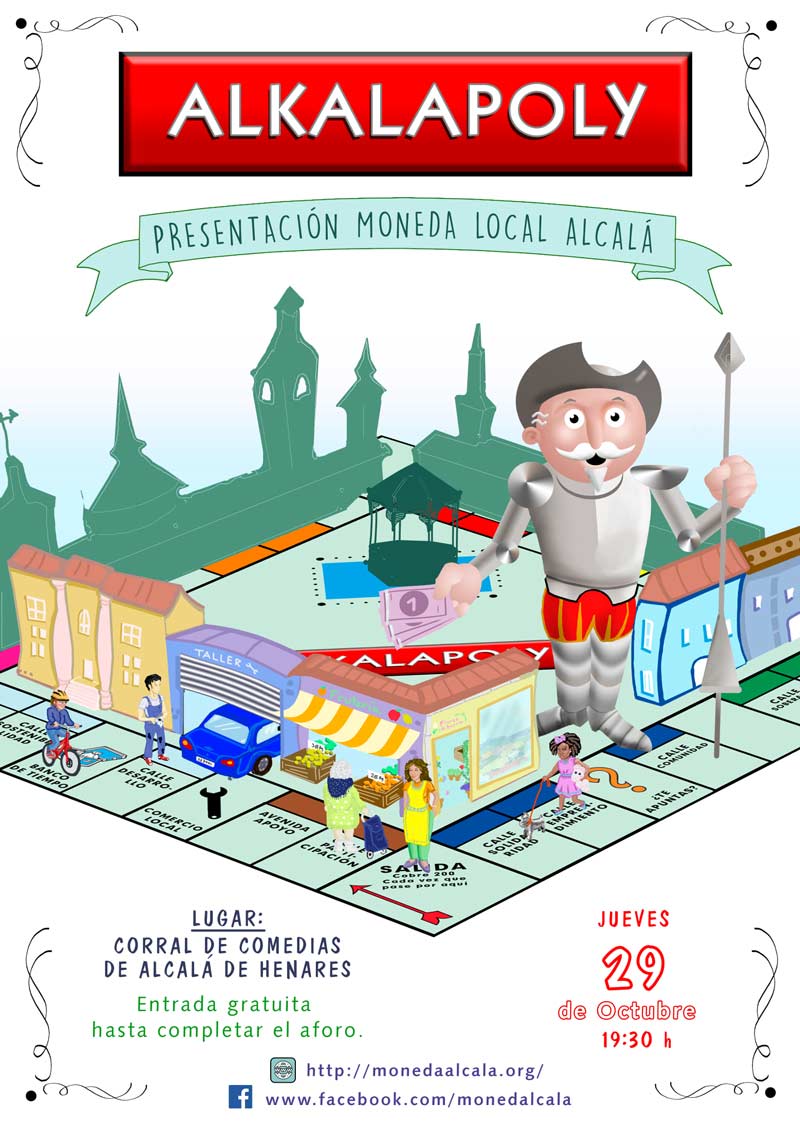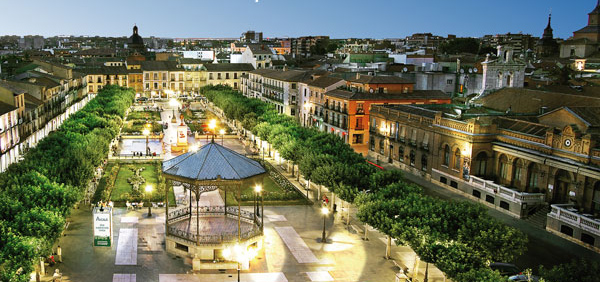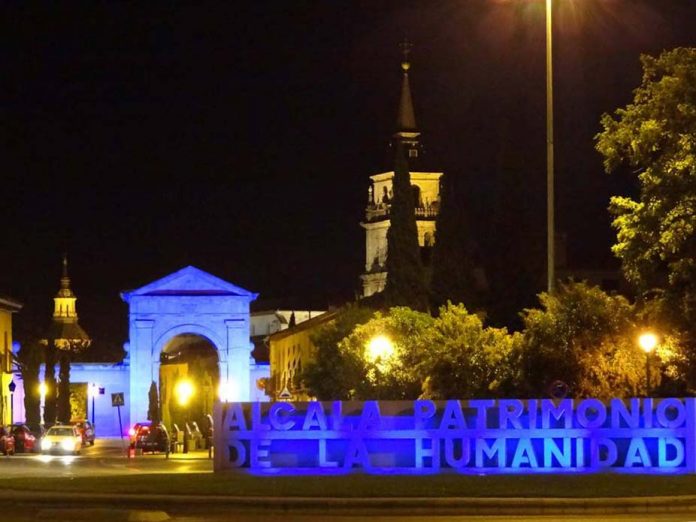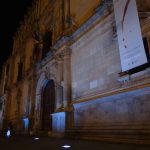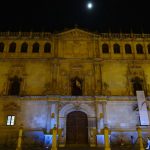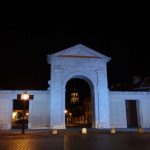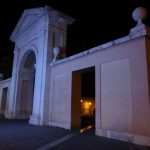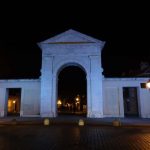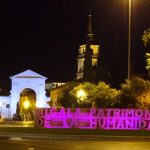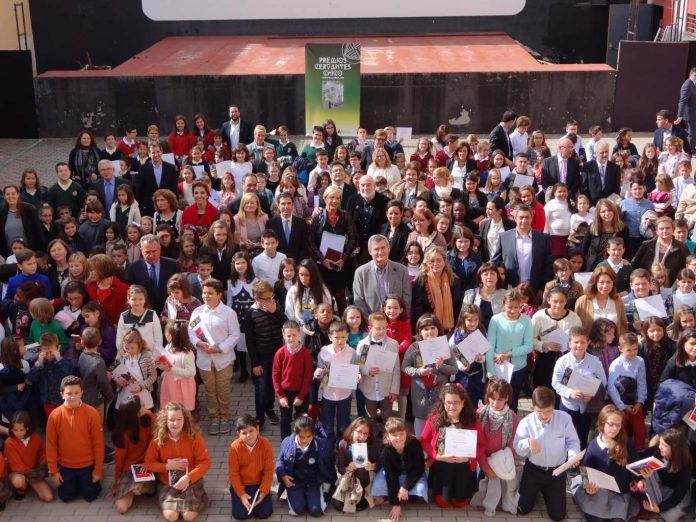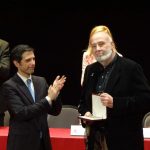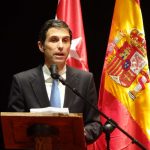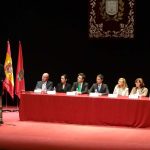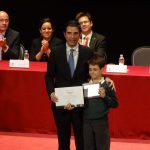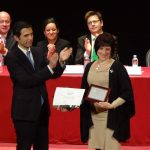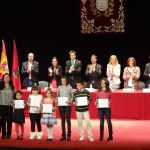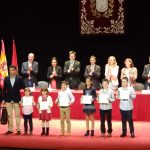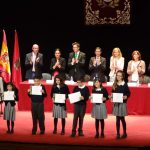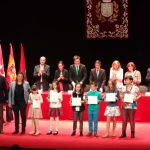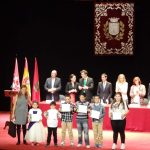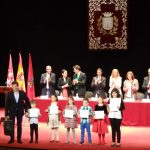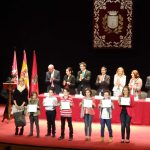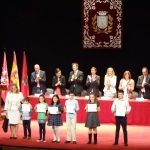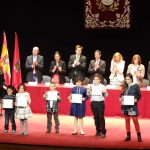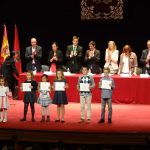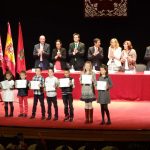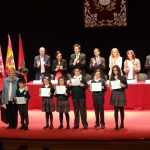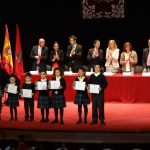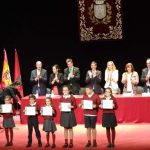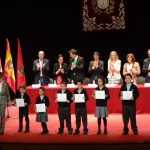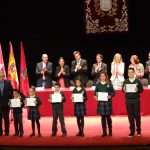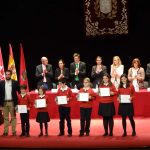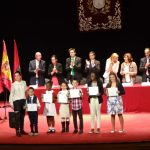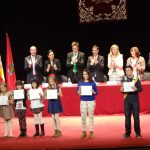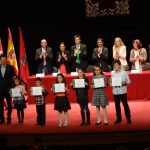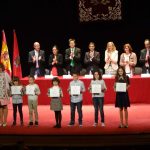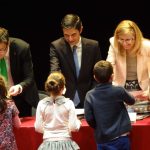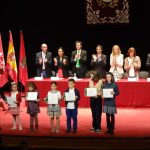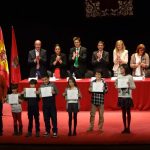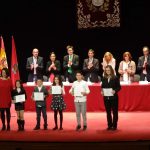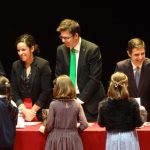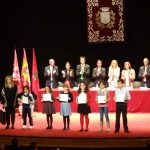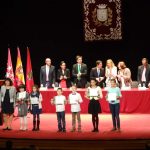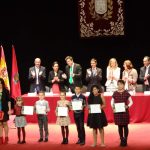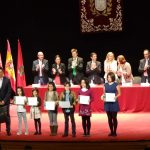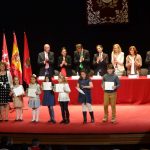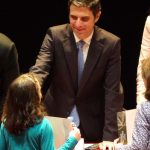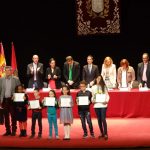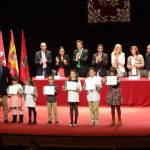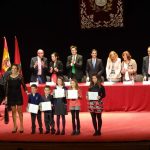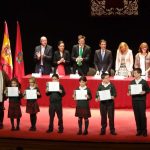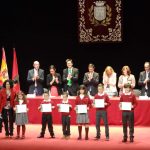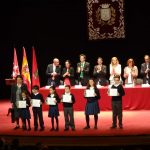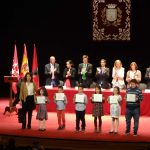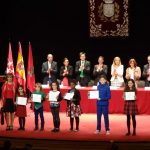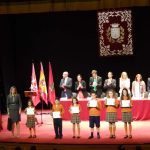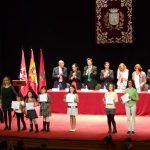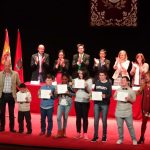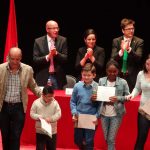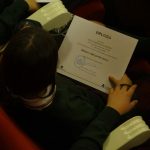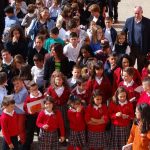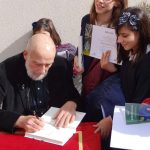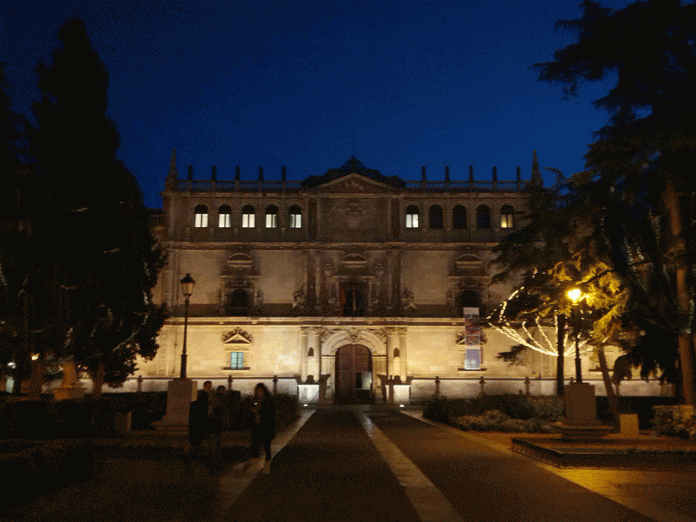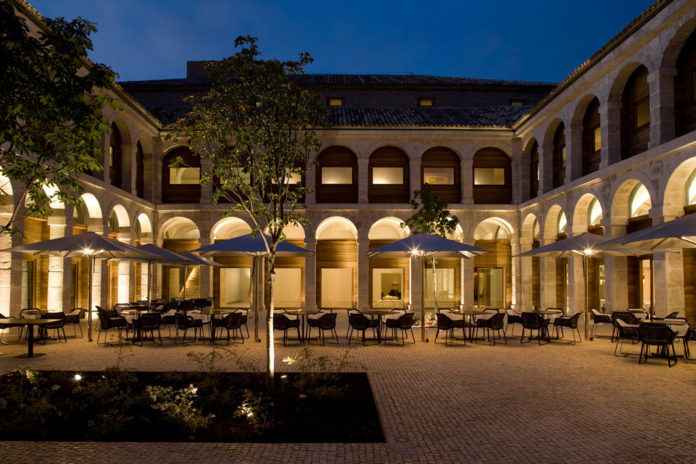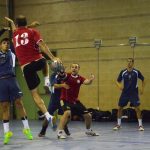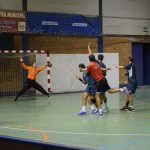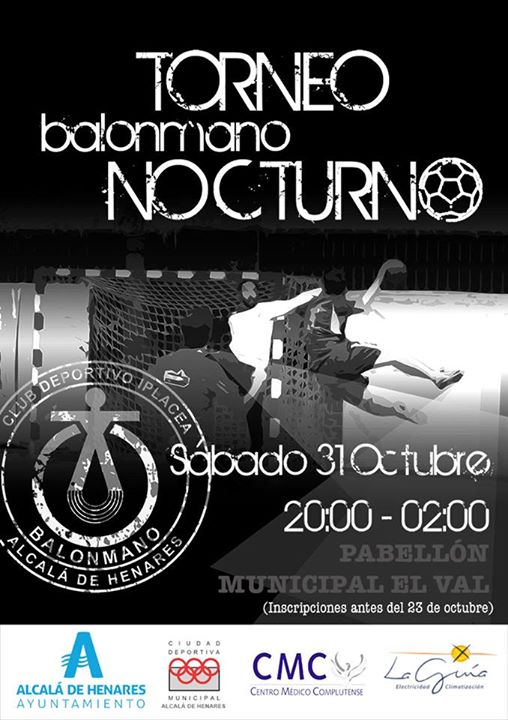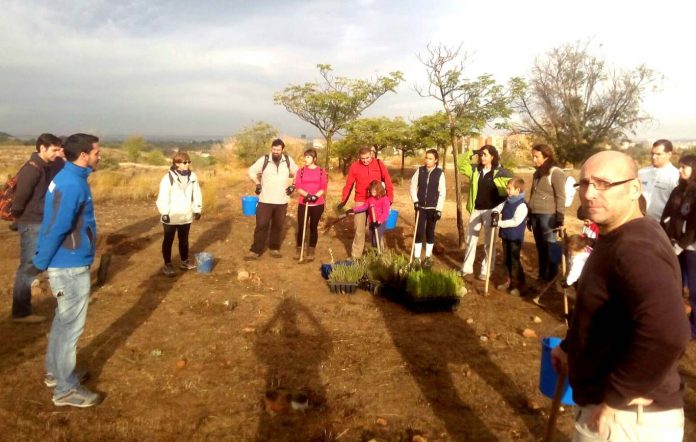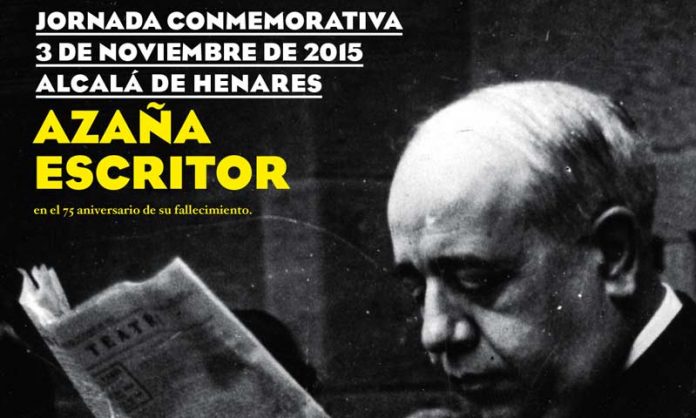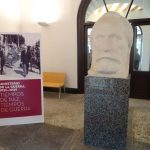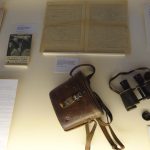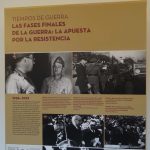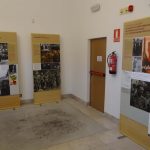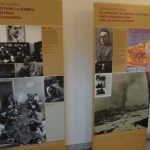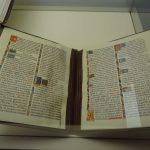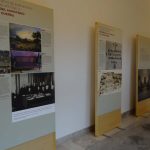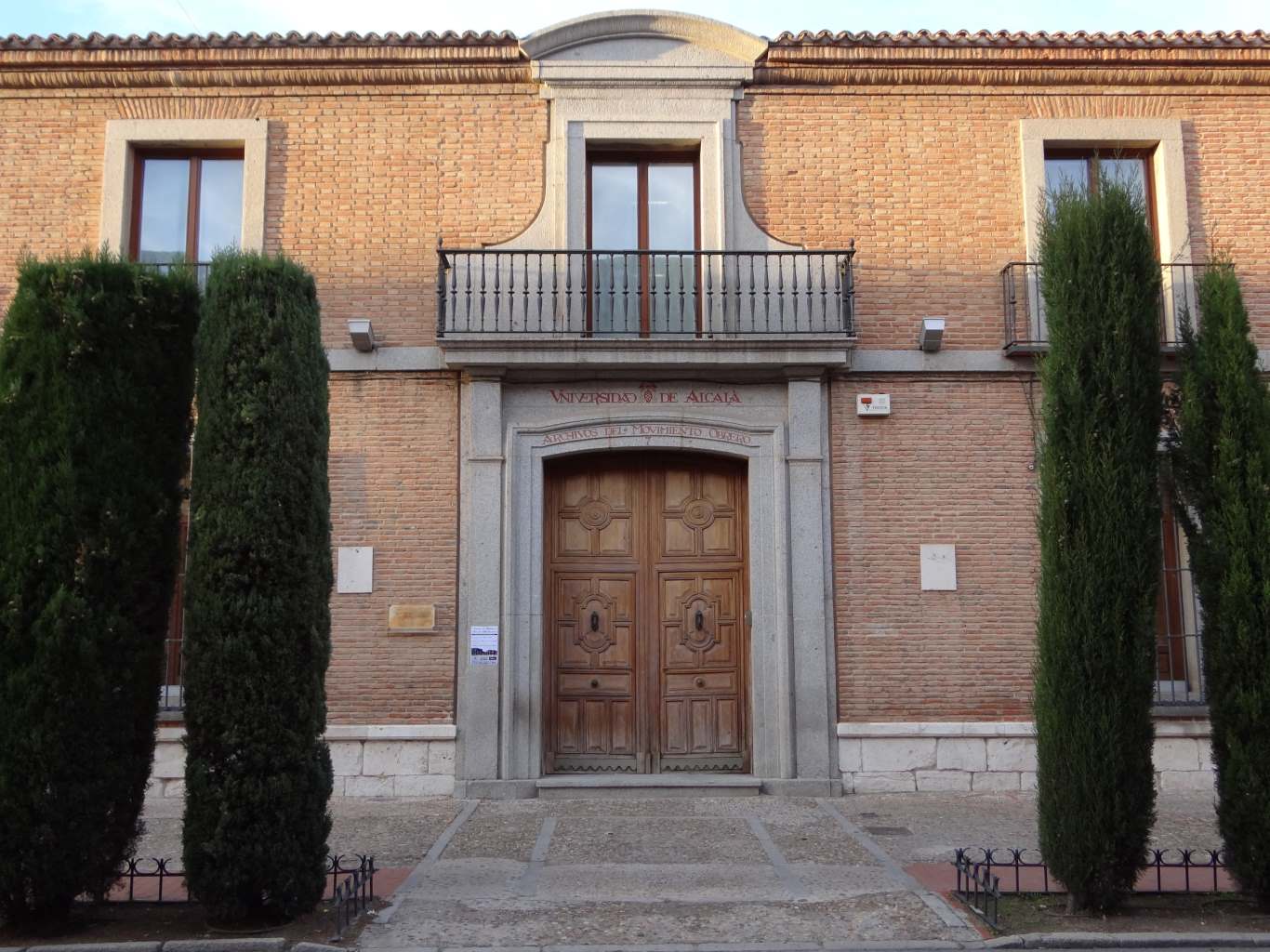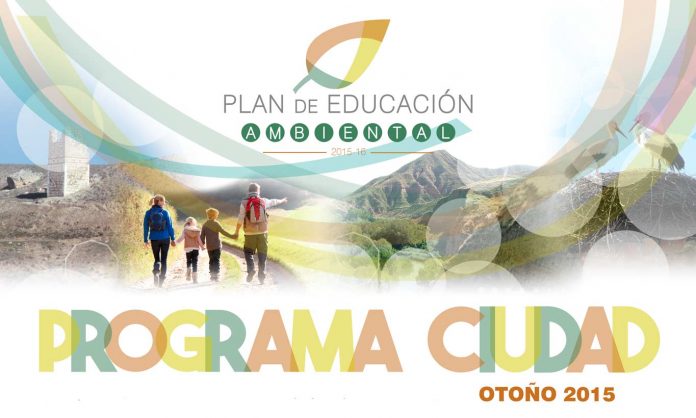Don Juan en Alcalá 2015 es la XXXI Representación Itinerante de Don Juan Tenorio de José Zorrilla, este año dirigida por Eduardo Velasco en versión de Yolanda Pallín.
Una representación ambientada en un escenario romántico que este año contará con Ginés García Millán en el papel de Don Juan tenorio y Miryam Gallego como Doña Inés de Ulloa, y que cada año consigue reunir a más de 20.000 personas en el casco histórico de Alcalá de Henares.
Cuándo y dónde podrás ver Don Juan en Alcalá 2015
Don Juan en Alcalá 2015 se representará el viernes 30 y el sábado 31 de octubre a las 20:00 horas en el Recinto amurallado del Palacio Arzobispal de Alcalá de Henares (ver en Google Maps) y el acceso será gratuito. Este es el plano de los distintos escenarios:

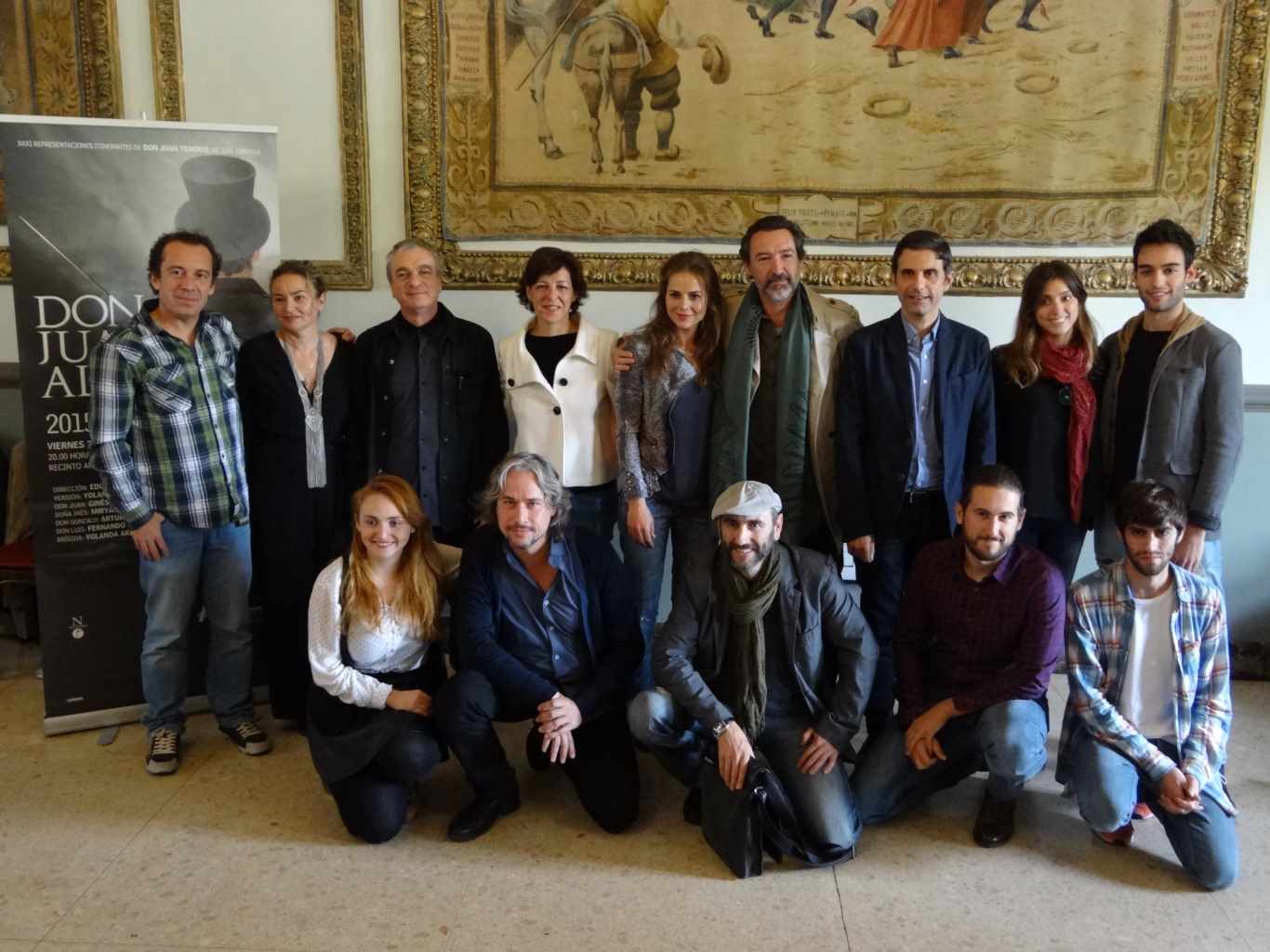
Reparto
(por orden de intervención en la obra)
Don Juan Tenorio: Ginés García Millán
Cristófano Buttarelli: Héctor Carballo
Marcos Ciutti: José Ramón Iglesias
Miguel: Edu Vasco
Don Gonzalo de Ulloa: Arturo Querejeta
Don Diego Tenorio: Jacinto Montes de Oca
Don Rafael de Avellaneda: Jesús Calvo
El Capitán Centellas: Rafael Ortiz
Don Luis Mejía: Fernando Sendino
Gastón: Ángel Galán
Pascual: José Vicente Ramos
Alguacil 1: Sergio Martín Puñal
Alguacil 2: Miguel Ángel Amor
Doña Ana de Pantoja: Cristina Adua
Brígida: Yolanda Arestegui
Lucía: Lorena López
Doña Inés de Ulloa: Miryam Gallego
La Abadesa de las Calatravas: Isabel Rodes
La Tornera de us Calatravas: Helena Unza
Un escultor: Francisco Rojas
Músicos: Coro de jóvenes de Madrid
Dirección: Eduardo Vasco
Equipo Artístico:
Versión: Yolanda Pallín Música: Eduardo Vasco/ Escenografía: Carolina González/ Vestuario: Emilio Salinas/ Iluminación: Miguel Ángel Camacho/ Colaboración especial y maestro de armas: José Luís Massó/ Ayudantes de dirección: Daniel Santos y Fran Guinot Dirección del coro: Juan Pablo de Juan Productor: Miguel Ángel Alcántara
Coproducida por el Área de Cultura y Universidad, Turismo y Festejos del Excmo. Ayuntamiento de Alcalá de Henares y Noviembre Compañía de Teatro S.L
Los actores
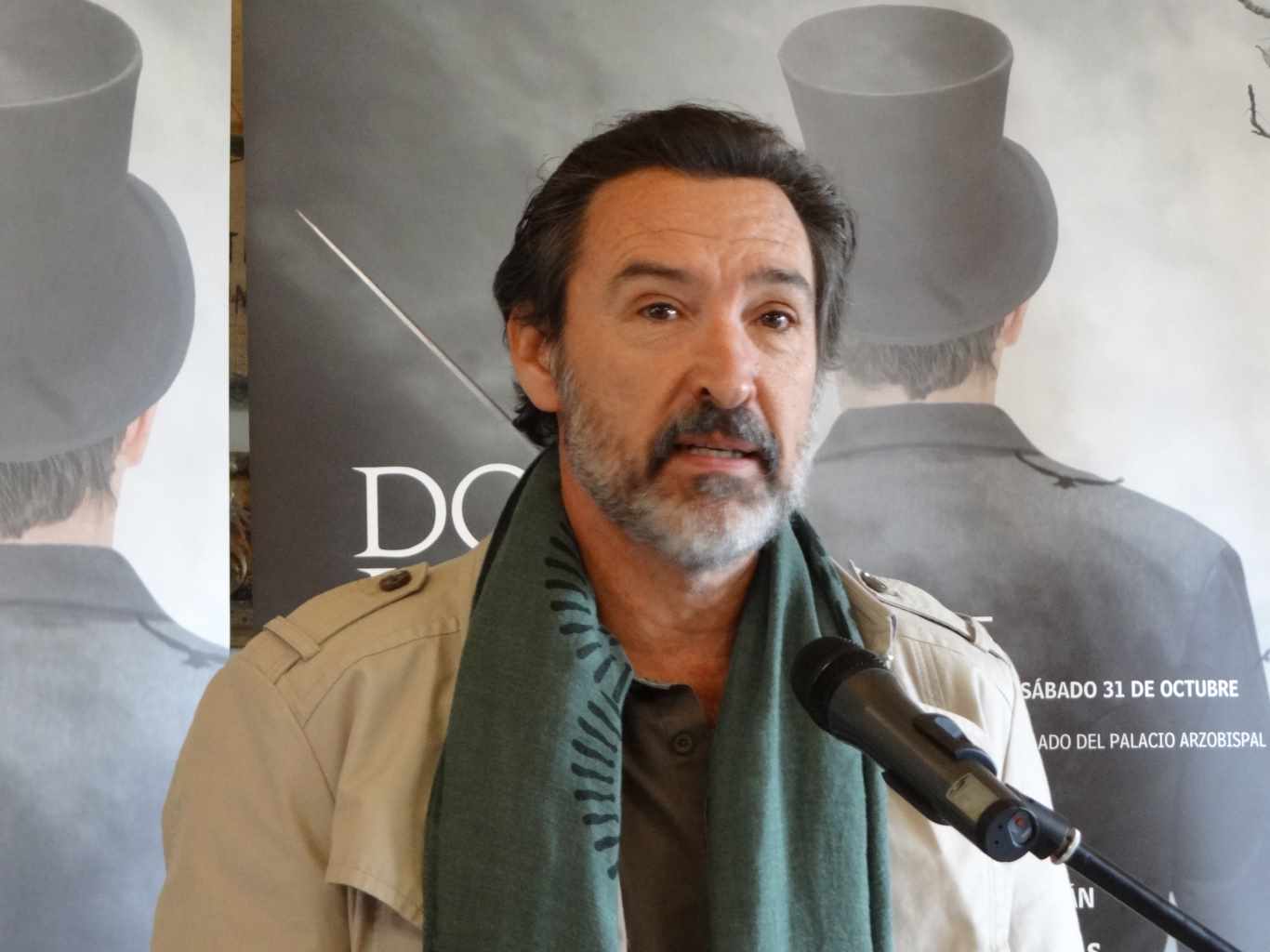 GINÉS GARCÍA MILLÁN/ Don Juan
GINÉS GARCÍA MILLÁN/ Don Juan
TELEVISIÓN
Protagonistas
Cuéntame cómo pasó, Óscar Aibar, Antonio Cuadri, Azucena Rodríguez
Frágiles, César Arriego, Rodrigo Sorogoyen
Isabel, Jordi Frades, Oriol Ferrer, Max Lemcke, José María Caro
La Señora, Jordi Frades, Belén Macías, Jorge Torregrossa, Salvador Gª Ruiz
Herederos, Norberto López, Joaquín Llamas y Jorge Torregrosa
Matrimonio con hijos, Ricardo A. Solla
Motivos personales, Salvador Calvo, Ignacio Mercero y Rafael Monleón
Un lugar en el mundo, Belén Macías y Jorge Torregrosa
Periodistas, Daniel Écija
Todos los hombres sois iguales, Jesus Font
Nazca, Benito Rabal
Episódicos
Galerías Velvet, Jorge Sánchez‐Cabezudo
Fuera de control, Manuel Valdivia
El comisario, Alfonso Arandia
Robles, investigador, Pedro Costa
Policías, Jesús del Cerro
Raquel busca su sitio, Rafael Moleón
Condenadas a entenderse, Azucena Rodríguez
A las once en casa, Eva Lesmes
La banda de Pérez, Josetxo San Mateo
Médico de familia, Daniel Écija
Curro Jiménez II, Benito Rabal
Mini Series
Tres días de abril, David Alonso
Adolfo Suárez, Sergio Cabrera
Amar en tiempos revueltos, Asier Aizpuru
Diario de un skin, Jacobo Rispa
CINE
La Punta del Iceberg, David Cánovas
Felices 140, Gracia Querejeta
Vulcania, José Skaff
María Montez: The Movie – Vicente Peñarrocha
The food guide for love (Amor en su punto) – D. Harari y T. Pelegri
5 de Mayo: La Batalla – Rafa Lara
Entre el cielo y el mar – Chumilla Carbajosa
23‐F – Chema de la Peña
The Unmaking of – Chumilla Carbajosa
Hotel Tívoli – Antón Reixa
Amor en defensa propia – Rafa Ruso
Reinas – Manuel Gómez Pereria
Pasos – Federico Luppi
Escuela de seducción – Javier Balaguer
Iris – Rosa Vergés
El año del diluvio – Jaime Chávarri
100 maneras de acabar con el amor – Vicente Pérez Herrero
Carmen – Vicente Aranda
El regalo de Silvia – Dionisio Pérez Galindo
Sólo mía – Javier Balaguer
Gitano – Manuel Palacios
Entre las piernas – Manuel Gómez Pereira
Mensaka – Salvador García
Insomnio – Chus Gutiérrez
Mamá es boba – Santiago Lorenzo Jiménez
Retrato de mujer con hombre al fondo – Mannane Rodríguez
Tabarka – Domingo Rodes
Felicidades, Tovarich – Antonio Eceiza
El infierno prometido – J. M. Chumilla
TEATRO
Jugadores de Pau Miró, Pau Miró
Kathie y el hipopótamo de Vargas Llosa , Magüi Mira
Los hijos se han dormido (versión de La Gaviota de Chejov) – Daniel Veronese
Las bicicletas son para el verano de Fernán Gómez, Emma Cohén
(Radioteatro para la Cadena SER)
La Iliada de Alesandro Baricco, Andrea D’Odorico (RNE)
Paseo Romántico, Laila Ripoll
Glengarry Glenn Ross de David Mamet, Daniel Veronese
Mujeres soñaron caballos de Daniel Veronese , Daniel Veronese
50 voces para Don Juan – Mario Gas Coriolano de William Shakespeare (Coriolano) – Elena Pimenta Hamlet de William Shakespeare (Hamlet) – Eduardo Vasco Don Juan Tenorio de José Zorrilla (Don Juan) – Eduardo Vasco Los vivos y los muertos de Ignacio García May – Eduardo Vasco La fundación de Buero Vallejo J. C. Pérez de la Fuente El rey Lear de Shakespeare – Miguel Narros El enfermo imaginario de J. B. Moliere – Luis Olmos Corazón de cine de Ignacio García May – Ignacio García May La doble inconstancia de Mariveaux – Miguel Narros Boca de cowboy de Sam Shephard – Patsy Fuller Así que pasen cinco años de Lorca – Miguel Narros Chanteclert de Rostand – Juan Antonio Vizcaíno ¡Hamlet! de Shakespeare – Ignacio García May
CORTOS
Don Enrique de Guzmán – Arantxa Echeverría / Meine Liebe – Ricado Steinberg y Laura Pousa
Estocolmo – Miguel Larraya / Morir, dormir, soñar – Miguel del Arco / Manchas – Jorge
Torregrosa
Palos de ciego amor – Miguel del Arco / Perdidos – Humberto Miró / Flores ‐David Ilundaín
PREMIOS
Nominado al mejor actor protagonista de la Unión de Actores 2013 por Isabel.
Premio al mejor actor en el Festival de Cine de Mula 2013 por el cortometraje Enrique de
Guzmán.
Nominado al mejor actor secundario de la Unión de Actores 2012 por 23‐F.
Premio mejor actor secundario de teatro de la Unión de Actores 2011 porGlengarry Gleen Rose.
Premio mejor actor en el Festival Medina del Campo 2011 por su papel en Meine Liebe.
Premio Villa de Madrid 2008 de interpretación dramática de teatro Ricardo Calvo por su
interpretación en la obra Mujeres soñaron caballos,
representada en el Teatro Valle‐Inclán, y como reconocimiento a su intensa trayectoria
profesional.
Premio mejor actor secundario de la Unión de Actores 2007 por Herederos.
En 2003, por el cortometraje Palos de Ciego Amor de Miguel del Arco, premio al mejor actor en
los festivales de Alfás del Pí, Medina del Campoo, Lorca, Antequera, Ponferrada.
Premio al mejor actor por cortometraje Flores en el Festival de Artorga.
Nominado al mejor actor protagonista de teatro en los Premios de la Unión de Actores 2000 por Don Juan Tenorio.
Premio de interpretación al reparto de Mamá es boba en el Festival de Cine de Alcalá de Henares
de 1997.

MIRYAM GALLEGO/ Doña Inés de Ulloa
Licenciada en Arte Dramático por la RESAD. Madrid, 1998.
Curso de Aptitud Pedagógica CAP. Didáctica de Expresión Artística. 1999. Comedia del Arte con
Antonio Faba. Juego Mímico con Luca Aprea. Voz y Canto con Mia Patterson. Canto con Inés
Ribadeneira.
Vanguardias Artísticas con Lourdes Ortiz. Danza Clásica y flamenco con Miguel Sandoval. Voz y
Técnicas de Respiración con Thomas Clements. Escenografía con Juan Manuel Sánchez. Clásico‐
Lope de Vega con María Ruiz. Jóvenes directores de escena. Escuela Europea.
TELEVISIÓN
Personajes fijos
Águila Roja. Serie para TVE. Personaje Marquesa de Santillana. 2009‐2013
Hospital Central. Serie Tele 5. Personaje Merche. 2007
Lobos. Serie para Antena3. Personaje Lucía. 2005
Periodistas. Serie para Tele 5. Personaje. Claudia. 2000‐2002
Personajes episódicos
Génesis. Serie para Cuatro. Capítulo 21. 2007
Aida. Serie Tele 5. Capítulo 38. 2006
El Comisario. Serie para Tele 5. Capítulo La Jauría. 2000
Policías en el corazón de la calle. Serie Antena 3. Capítulo 4. Un perro ladra en la Tormenta. 1999
Encuentros. Dirigido por José Luis Arellano y Carlos Montero. 1998
Platos Combinados. Tele‐Comedia para TVG. 1995‐1997
TEATRO
El Rey Lear. Dirigida por Gerardo Vera. CDN. Personaje Cordelia. 2008
Arsénico por Favor. Director Gonzalo Suárez. Personaje Elena. Mapa Producciones. 2002‐2003
Roberto Zucco. Teatro del Duende. Personaje La chiquilla. 2001
Combate de Negro y de Perros. Dirigida por Marta Riganti. Personaje Leona. 1999
El Motel de los Destinos Cruzados. Lectura Dramatizada dirigida por Raquel Toledo.1999
Santa Cruz. Compañía Teatro del Duende. 1998
Bodas de Sangre. Dirigida por Juan Pastor. Personaje La novia. La Luna. 1998
Roberto Zucco. Dirigido por Jesús Salgado. Personaje La chiquilla. 1997
A Esmorga. Dirigida por Ánxeles Cuña. Compañía Teatro Sarabela. 1995‐1997
CINE
Paraíso. Dirigida por Mariana Chenillo. Canana Films. 2013
La voz dormida. Dirigido por Benito Zambrano 2011
Águila roja. Dirigido por José Ramón Ayerra. 2011
Aquí estoy y aquí me quedo. Cortometraje. Dirigido por Hazael Muñoz. 2008
Concursante. Director Rodrigo Cortés. La zona films. 2007
PUBLICIDAD
Anuncio para Telefónica. Campaña navideña. 2002‐03
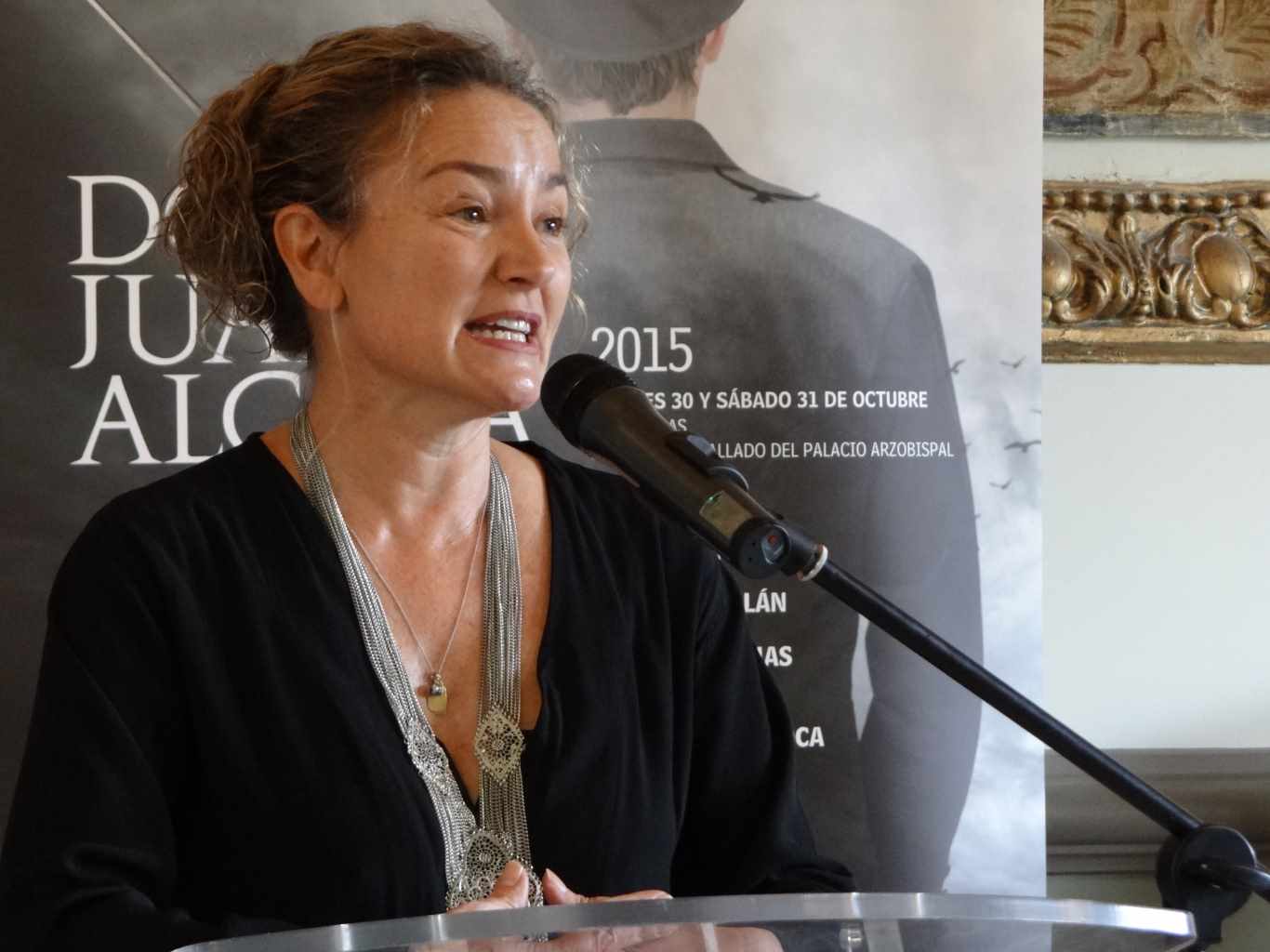
YOLANDA ARESTEGUI/ Brígida
TEATRO
RESAD. Real Escuela de Arte Dramático de Madrid. Ha trabajado como actriz par televisión y teatro.
Rumores de Neil Simon´s. Dirigida por Pedro de las Heras. De Descalzos Producciones. 2011
Se infiel y no mires con quien Producida por descalzos producciones. 2008/2010
Historia de una Escalera. Director Juan Carlos Pérez de la Fuente (C.D.N). 2003
Federica de Bramante. Teatro Real Cinema (Dir. Pedro García de las Heras). 2002.
Descalzos por el Parque de Neil Simon dirigida por Pilar Massa. 1999‐2000
La XV y XVI representaciones de Don Juan en Alcalá dirigidas por María Ruiz. 1999‐2000
La Dama Duende de Calderón dirigida por Antonio Guirau en La Muralla Árabe dentro de los
Veranos de la Villa, 1998.
La Vida es Sueño de Calderón dirigida por Ariel García‐Valdés en la Cía. Nacional de Teatro
Clásico. 1996‐1997
El Acero de Madrid de Lope de Vega dirigida por José Luis Castro en la Cía. Nacional de Teatro
Clásico. 1995
Don Gil de las Calzas Verdes de Tirso de Molina dirigida por Adolfo Marsillach en la Cía. Nacional
de Teatro Clásico. 1994
Traidor, inconfeso y Mártir de Zorrilla dirigida por Gustavo Pérez‐Puig en el Teatro Español de
Madrid. 1993
Tres Sombreros de Copa de Mihura dirigida por Gustavo Pérez‐Puig en el Teatro Español de
Madrid. 1992
Música cercana de Buero Vallejo dirigida por Gustavo Pérez‐Puig. 1990
La Manma en la Cía. de Florinda Chico dirigida por Ángel Montesinos. 1989
Cuatro corazones con freno y marcha atrás de Jardiel Poncela dirigida por Gustavo Pérez‐Puig.
1988
La Venganza de Don Mendo de Muñoz Seca dirigida por Gustavo Pérez‐Puig. 1987.
Entre 1983 y 1986 participa en diferentes montajes del Teatro de Cámara de Madrid dirigidos por
Ángel Gutiérrez :
Los balcones de Madrid de Tirso de Molina;
Las picardías de Scapin de Moliere;
Los escándalos de un pueblo de Goldoni;
El Jardín de los cerezos de Chejov
TELEVISIÓN
Bandolera (TV Series) 2012‐2013 Doña Carlota
La curva de la felicidad. (TV Series) 2011. Carmen
El internado (TV Series) 2008‐2010. Irene Espí
No estás sola, Sara (TV Movie) 2009. Luisa
Corazón en sombras (Short) 2008. Elena
Gominolas (TV Series) 2007. Ingrid
Groucho (Short) 2007
Cuenta atrás (TV Series) 2007 Isabel
Aída (TV Series) 2006 Cecilia
Supervillanos (TV Series) 2006. Suna
Fuera de control (TV Series) 2006. Ana
Casi perfectos (TV Series) 2004‐2005. Elena
El comisario (TV Series) 2002
Al salir de clase (TV Series) 2001‐2002. Begoña
Ciudad sur (TV Series) 2001. Bea
Don Juan Itinerante (TV Movie). 2000. Doña Inés
7 vidas (TV Series). 2000. Sonia
Don Juan Itinerante (TV Movie) 1999. Doña Inés
Primera función (TV Series) 1989. Adela
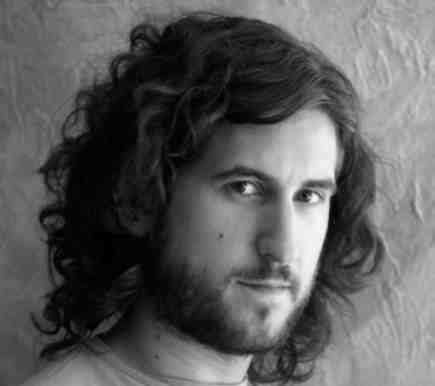
HÉCTOR CARBALLO/ Cristófano Buttarelli
Licenciado en Arte Dramático en la University of Kent at Canterbury, 2003‐2007 (Madrid). Formación: Entrenamiento profesional ante la Cámara. Impartido por: Macarena Pombo. Interpretación ante la Cámara (Central de Cine). Impartido por: Eva Lesmes. Interpretación ante la Cámara (Central de cine). Impartido por: Daniela Féjerman. Interpretación para cine: comedia (Central de cine). Impartido por: Eva Lesmes. Interpretación sobre textos de Shakespeare: Impartidos por Will Keen, Brigid Panet y Katya Benjamin (Profesores de la R.A.D.A.) Interpretación ante la Cámara (Plotpoint). Impartido por: Carlos De Matteis. Tres años en la Escuela de Actuación de Loly Buján. Impartido por: Loly Buján. Mimo y Clown. Impartido por: José Daniel Piris. Danza Contemporánea (nivel avanzado). Impartido por: Arnold Taraborrelli. Lucha Escénica: espada y daga. Impartido por: Jesús Esperanza. Lucha Escénica: doble sable (Estudio3). Impartido por: Paco Alberola. Monólogos Cómicos (Festiclown). Impartido por: Eva Hache.
TELEVISIÓN
ISABEL, Jordi Frades, J.Mª Caro, Max Lemcke, Oriol Ferrer. TVE (Papel Carlos VIII de Francia) El mariscal Pardo de Cela. Serie documental. Dirección: Damián Varela. 2006 La super cafetera. Serie online desde 2010. Productora: Pcmi. (Papel Principal.) Cortometrajes
Sunny Johnson. Cortometraje. Dirección: Maresa Burmester. (Papel Principal). 2010 Gorgo. Cortometraje. Dirección: Alberto Rodríguez. (Papel Principal). 2010 Pepa y Miguel. Cortometraje. Dirección: Maresa Burmester. (Papel Principal).2010 Las vidas de Lucas. Cortometraje. Dirección: Helena Martínez. (Papel Secundario) 2009 Remordimiento. Cortometraje. Dirección: Alberto Rodríguez. (Papel Principal).2008 La jaula. Cortometraje. Dirección: Alberto Rodríguez. (Papel Principal).2008 5000. Cortometraje. Dirección: Alberto Rodríguez. (Papel Principal). 2008 ¡Parados! Cortometraje. Dirección: José Luís Moreno. (Papel Principal). 2005 Esquizofrenia. Cortometraje. Dirección: Jesús Montalbán. (Papel Principal). 2005
TEATRO
Compañía Nacional de Teatro Clásico
Entremeses Barrocos. Autor: Calderón, Quirós y Moreto. Dirección: Pilar Valenciano, Héctor del
Saz, Elisa Marinas y Aitana Galán. 2011 (Papel secundario)
Todo es enredos amor. Autor: Diego de Figueroa. Dirección: Álvaro Lavín. 2010 (Papel secundario)
La moza de cántaro. Autor: Lope de Vega. Dirección: Eduardo Vasco. 2010 (Papel Secundario).
Con otras compañías
Grifo Y León, guardianes del museo. (Títeres) Autor y Dirección: Jon Sarasti. 2009 (Papel
Principal).
Garbancito. (Títeres) Autor y Dirección: Jon Sarasti. 2009 (Papel Principal).
El Deleitoso. Autor: Lópe de Rueda. Dirección: Agustín Iglesias. Guirigai Teatro. 2009 (Papel
Secundario).
Mara. Danza‐ teatro. Autor y Dirección: Marian Arriaga. 2008 (Papel principal) Festival de Almagro
Je t´aime. Autor y Dirección: David Vélez. 2008. Fándula Teatro. (Papel Principal). Festival de
Avignon
Pecados del Lobo. Autor: Clara Martín. Dirección: Juanjo Torres. 2007. 7 Lobos Teatro. (Papel
Principal).
Te quiero. Autor y Dirección: David Vélez. 2007. Fándula Teatro. (Papel Principal).
La boda de los Pequeños Burgueses. Autor: B. Bretch. Dirección: David Vélez. 2007 Fándula
Teatro. (Papel Principal).
La Vida es Sueño. Autor: P. Calderón de la Barca. Dirección: Agustín Iglesias. 2007 . Guirigai.
(Papel Secundario).
Os Pecados do Lobo. Autor: Clara Martín. Dirección: Héctor Carballo. 2006. 7 Lobos Teatro.
(Papel Principal).
Las Ferias de Madrid. Autor: Lope de Vega. Dirección: José Luis Tutor. 2005 (Papel Secundario).
¡Mamá, quiero ser famoso! Dirección y guión: Jordi Milán. Música: Joan Vives.2005. La Cubana.
(Apariciones especiales).
Fundador y director artístico de la compañía 7 LOBOS Teatro.
En el cielo de mi boca. Autor: José Padilla. Dir.: Jazz Vilá. (Ayudantía dirección) 2011
Nana para la niña vacía. Autor: Héctor Carballo 2009
El Bosque Brillante. Autor: Mar Montoso. 2007
Os Pecados do Lobo. Autor: Clara Martín. 2006
PROFESOR
Cursos de Lucha Escénica: Florete, espada y sable.
Curso de Caracterización de Actores.
Curso de Interpretación: “El entrenamiento del Actor”
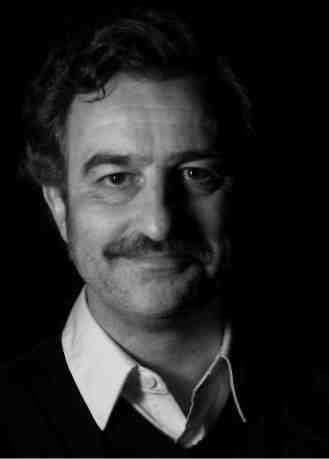
JOSÉ RAMÓN IGLESIAS/ Marcos Ciutti
Diplomado en Arte Dramático por el Instituto del Teatro y de las Artes Escénicas de Asturias (ITAE 91‐95). Desde 1.993 participa en más de cuarenta montajes teatrales. Diez de ellos con la Compañía Nacional de Teatro Clásico, a las órdenes de Directores tales como José Carlos Plaza, Pilar Miró, Jesús Cracio, David Ottone, J.C Pérez de la Fuente o Eduardo Vasco entre muchos otros.Participa en multitud de series de TV entre las que cabe destacar: Impares, Padres, El Secreto de Puente Viejo, Aída, El Ministerio del Tiempo…
TELEVISIÓN (selección de trabajos)
Oleuba (Short) (post‐production) Presentador 2015
El ministerio del tiempo (TV Series) 2015
Con el culo al aire (TV Series) 2014
Museo Coconut (TV Series) 2014
Aída (TV Series) 2013
La Gira: Luces, cámara, acción (TV Movie) 2013.
El secreto de Puente Viejo (TV Series) 2011.
Águila Roja, la película 2011
La Gira (TV Series) 2011.
Impares (TV Series) 2008‐2010.
El Divo (TV Series) 2009
Bicho malo (TV Series) 2009
Padres (TV Series) 2009
Lalola (TV Series) 2008
Física o química (TV Series) 2008
Cuéntame cómo pasó (TV Series) 2006
Matrimonio con hijos (TV Series) 2006
Paco y Veva (TV Series) 2004
Un lugar en el mundo (TV Series) 2003
Manos a la obra (TV Series) 2001
El botones Sacarino (TV Series) 2000

ARTURO QUEREJETA/ Don Gonzalo de Ulloa (comendador de Calatrava)
TEATRO
Con Noviembre Teatro
EL MERCADER DE VENECIA de W. Shakespeare, Eduardo Vasco
OTELLO de W. Shakespeare, Eduardo Vasco
NOCHE DE REYES de W. Shakespeare, Eduardo Vasco
HAMLET de W. Shakespeare, Eduardo Vasco
Con la Compañía Nacional de Teatro Clásico
ENTREMESES BARROCOS, P. Valenciano, E. Marinas, A. Galán, H. del Saz
UN BOBO HACE CIENTO de Antonio de Solís, JC. Pérez de las Fuente
EL CONDENADO POR DESCONFIADO de Tirso de Molina, Carlos Aladro
LA ESTRELLA DE SEVILLA de Lope de Vega, Eduardo Vasco
El PINTOR DE SU DESHONRA de Calderón de la Barca, Eduardo Vasco
EL CURIOSO IMPERTINENTE de Guillen de Castro, Natalia Menéndez
TRAGICOMEDIA DE DON DUARDOS de Gil Vicente, Ana Zamora
EL CASTIGO SIN VENGANZA de Lope de Vega, Eduardo Vasco
LA SERRANA DE LA VERA de Vélez de Guevara, María Ruiz
DON JUAN TENORIO de José Zorrilla, Maurizio Scaparro
PERIBÁÑEZ Y EL COMENDADOR DE OCAÑA de Lope, JL Alonso de Santos
DON JUAN de Molire, Jean‐Pierre Miquel
LA ESTRELLA DE SEVILLA de Lope de Vega,Miguel Narros
LA VIDA ES SUEÑO de Calderón de la Barca, Adolfo Marsillach
EL ACERO DE MADRID de Lope de Vega, José Luis Castro
EL MÉDICO DE SU HONRA de Calderón de la Barca, Adolfo Marsillac
DON GIL DE LAS CALZAS VERDES de Tirso de Molina, Adolfo Marsillach
FUENTEOVEJUNA de Lope de Vega, Adolfo Marsillach
LA GRAN SULTANA de Miguel de Cervantes, Adolfo Marsillach
LA NOCHE TOLEDANA de Lope de Vega, Juan Pedro de Aguilar
Otras obras destacadas
NOCHE DE REYES SIN SHAKESPEARE de Adolfo Marsillach, M.Lezcano
LA RATONERA de Agatha Christie, Ramón Barea
EL APAGÓN de Peter Shaffer, Jaroslaw UNA JORNADA PARTICULAR de Ettore Scola, Pedro M. Martínez ESCUADRA HACIA LA MUERTE de Alfonso Sastre, Antonio Malonda PARES Y NINES de J.L. Alonso de Santos, Gerardo Malla FUERA DE QUICIO de J.L. Alonso de Santos, Gerardo Malla BAJARSE AL MORO de J.L. Alonso de Santos, Gerardo Malla LA TABERNA FANTÁSTICA, Gerardo Malla
TELEVISIÓN
CUÉNTAME CÓMO PASÓ, Óscar Aibar y Agustín Crespi
ISABEL, Jordi Frades, J.Mª Caro, Max Lemcke, Oriol Ferrer
14 DE ABRIL. LA REPÚBLICA, J. Torregrossa, N. López Amado, J. Frades
EL SECRETO DEL PUENTE VIEJO, Inma Torrente, Luis Santamaría
FÍSICA O QUÍMICA, Carlos Navarro Ballesteros, Juanma R. Pachón
HOSPITAL CENTRAL, J.L Gª Berlanga, Javier Pizarro
AMAR EN TIEMPOS REVUELTOS, Diego Lesmes
MOTIVOS PERSONALES, Ignacio Mercero, César Rodríguez, Salvador Calvo
EL PANTANO, Pepa Sánchez Biedma
ABOGADOS, J.M.Paino
EL COMISARIO, Norberto López Amado, Ignacio Mercero, Jesús Font
AL SALIR DE CLASE, Pepa Sánchez Biezma
ROBLES: INVESTIGADOR PRIVADO, Josetxo San Mateo
LA VIDA EN EL AIRE, Ignacio Mercero
OH ESPAÑA, Dagoll Dagom
CARMEN Y FAMILIA, Pablo Ibáñez
LA HUELLA DEL CRIMEN, Imanol Uribe
EVA Y ADÁN, J.L. Alonso de Santos
LA FORJA DE UN REBELDE, Mario Camus
LA CASA DE LAS CHIVAS, Sergi Shaft
BRIGADA CENTRAL, Pedro Masó
CINE
Largometrajes
PLANTA CUARTA, Antonio Mercero
ATRACO A LAS TRES Y MEDIA, Raúl Marchant
CACTUS, Pau Freixas
LUZ NEGRA, Xavier Bermúdez
LA DIPUTADA, Javier Aguirre
Cortometrajes
LAS SUERTES, Alejandro Marcos
ENDORA, Fernando Mainguyuague
PREMIOS
PREMIO ÁGORA DEL FESTIVAL DE TEATRO CLÁSICO DE ALMAGRO PREMIO DEL PÚBLICO DE VALLADOLID
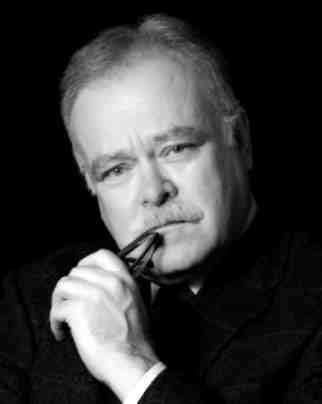
JACINTO MONTES DE OCA/ Don Diego Tenorio
Formación durante tres años (2006, 2007 y 2008) en el Aula de Teatro de la Universidad de Alcalá de Henares.
Curso de interpretación impartidos por Santiago Alonso (2009, 2010 y 2011)
Formación durante dos años (2012 y 2013) en la Escuela Teatro de Cámara Chejov, Impartido por
Ángel Gutiérrez, fundador y director artístico del Teatro de Cámara Chejov.
Curso de interpretación impartidos por Santiago Alonso en Taller de Teatro.
TEATRO (selección de trabajos)
Don Juan de Alcalá. José Zorrilla. Dirección Carlos Aladro 2014. Personaje: Diego Tenorio
Don Juan de Alcalá. José Zorrilla. DirecciónCarlos Aladro 2013. Personaje: Diego Tenorio
Don Juan en Alcalá. José Zorrilla. Dirección Jorge Muñoz 2012Personaje: Diego Tenorio
Las Noches de Don Juanen Alcalá. Pilar González y Martín Puñal. Productora Cervantalia. 2010,
2011, 2012, 2013 y 2014. Personaje: Don Gonzalo de Ulloa
Una mujer sin importancia. Oscar Wilde. Dirección Santiago Alonso. 2009. Taller de Teatro
Los árboles mueren de pie. Alejandro Casona. Dirección Santiago Alonso. 2010. Taller de Teatro
Otras actividades escénicas
La Noche de los libros. Lecturas dramatizadas de Juan Marsé y José Emilio Pacheco Premios
Cervantes 2009 y 2010
Poesía en los claustros. Festival de la Palabra. Poemas y textos del Siglo de Oro en la Universidad de Alcalá de Henares. 2006, 2007 y 2008
CINE
La Espina de Dios. Oscar Parra de Carrizosa. Personaje: Jairo.2.015
TELEVISIÓN
Episódicos
El Secreto de Puente Viejo. David Montoya 2015. Capítulos 1.157, 1.159 y 1.160 Antena 3
La que se Avecina. Producción Tele 5
OTRAS ACTIVIDADES AUDIOVISUALES
Spot publicitarios y promocionales para distintas campañas Promocionales corporativos para empresas
 JESÚS CALVO/ Avellaneda
JESÚS CALVO/ Avellaneda
Licenciado en Interpretación por la R.E.S.A.D. / 1988‐92. Interpretación Audiovisual Luis Gimeno / Universidad de Alcalá de H. /2000. Curso de verano de Interpretación/ IFEMA‐C.A.M. /2001 Técnicas de Doblaje/ CAM / 2003. Curso de Shakespeare Helena Pimenta/Arte4/ 2003. Entrenamiento para actores / Arte4 / 2002‐04. Interpretación Bob McAndrew/ Arte4 / 2002/04. Interpretación con Andrés Lima / U.I.M.P. / 2010. Interpretación con Tamzin Townsend / 2011
CINE
“MOZZARELLA LETAL”‐ Dirección José Antonio Barquillal. Littleboat producciones. 2014 “UNDO INFINITO”‐ Dirección Álex Mendíbil. Dentro de #littlesecretfilm. 2013 “ESTADO DE REGRESIÓN”‐ Dirección Álex Mendíbil. Co‐protagonista. Dentro de #littlesecretfilm por Calle13/ 2013
TELEVISIÓN
“EL SECRETO DE PUENTE VIEJO”‐ A3‐Boomerang TV, S.A. 2015. cap.1.120, 1.121, 1.126, 1.130.
“CUÉNTAME COMO PASÓ”‐ TV1‐Grupo Ganga Producciones S.L. 2014. cap.270.
“HOSPITAL CENTRAL”‐ Tele5‐Videomedia Producciones. 2011. cap.486.
“YO SOY BEA”‐ Tele5‐Grundy Producciones S.A. 2008. cap.482/485/486/489/490.
“EL PORVENIR ES LARGO”‐ TV1.‐ cap.36. 2008.
“PLANTA 25”‐ TeleMadrid. Miramón Mendi S.A.‐ cap.8. 2006
“AQUÍ NO HAY QUIEN VIVA”‐ A3. Miramón Mendi S.A.‐ cap.61. 2005
“LOBOS”‐ A3. VideoMedia Producciones‐ cap.02/03. 2004
“SOPA BOBA”‐ A3. Miramón Mendi S.A.‐ cap.11. 2004
“MANOLITO GAFOTAS”‐ A3. Filmax TV‐ cap.11. 2004
“HOSPITAL CENTRAL”‐ Tele5. VideoMedia Producciones‐ cap.88. 2003
“POLICIAS”‐ Tele5. GloboMedia Producciones‐ cap. 80. 2002
“HOSPITAL CENTRAL”‐ Tele5. VideoMedia Producciones‐ cap.57 / 62. 2002
“MEGATRIX”‐ A3. Aventura TV, 3 Programas. 2002
“MEGATRIX”‐ A3. Pausoka Producciones. Cámara oculta, 9 programas. 2002
«OJO QUE NOS VEN»‐ TM. Pausoka Producciones. Cámara oculta, 4 programas. 2002
“MALDITA LA HORA”‐ A3. Zeppelin Televisión. 3 programas. 2001
“ESENCIA DE PODER”‐ Tele5. Zeppelin Televisión‐ cap.74 / 75. 2001
“HOSPITAL CENTRAL”‐ Tele5. VideoMedia Producciones‐ un cap. 2001
“BOTONES SACARINO”‐ Ficción TV‐ cap. 3 2000
“24 HORAS”‐ A3. Creativos Asociados Radio y Televisión‐ cap. 6º / 14º. 1991‐2000
“CALLE NUEVA”‐ TV1.Zeppelin Televisión. cap. 489º / 490º/ 2000
“RAQUEL BUSCA SU SITIO”‐ TV1. Tesauro Producciones‐ cap. 3º / 10º/ 1999‐2000
“MANOS A LA OBRA”‐ A3. Acanto Cine Vídeo‐ cap. «¡Vaya Belén!». / 1999
“LO + PLUS”‐ Canal +. 39 programas./ 1998‐2000
TEATRO
“Eterno Creón” basado en “La Tebaida” de Racine dramaturgia Manuel De. Direc.‐Manuel De/
2014‐2015
“Antes que todo mi dama” de Calderón de la Barca. Direc.‐Víctor Manuel Dogar. Cía.‐Teatro del
Biombo. 2014/2015
“Abrevi4ndo” de Cervantes, Molière y Anónimo. Direc.‐Víctor Manuel Dogar. Cía.‐Teatro del
Biombo 2013/ 2014
“NOCHE DE REYES” de Williams Shakespeare. Direc.‐Eduardo Vasco. Cía.‐Noviembre Teatro/
2012/ 2013
“ENTREMESES BARROCOS”. Direc.‐Pilar Valenciano, Elisa Marinas, Aitana Galán, Héctor del Saz
Cía.‐C.N.T.C./ 2011‐2012
“UN BOBO HACE CIENTO” de Antonio de Solís y Rivadeneira. Direc.‐ Juan Carlos Pérez de la
Fuente. Cía.‐C.N.T.C./ 2011
“CONDENADO POR DESCONFIADO” de Tirso de Molina. Direc.‐Carlos Aladro. Cía.‐C.N.T.C./ 2010
“LA ESTRELLA DE SEVILLA” de Lope de Vega. Direc.‐Eduardo Vasco. Cía.‐ C.N.T.C. (Compañía
Nacional de Teatro Clásico) / 2009
“EL AMOR QUE NO OSA DECIR SU NOMBRE” de María Cereijo basado en DE PROFUNDIS de
Oscar Wilde. Direc.‐Fernando Calatrava. Cía.‐ P4T. Teatro de LAS AGUAS. Madrid./ 2008
“MOLIERE POR DOS‐(LA ESCUELA DE LOS MARIDOS/LAS PRECIOSAS RIDICULAS)” de Molière.
Direc.‐ Adrián Daumas. Festivales de Teatro Clásico como Almagro, Olite y El Escorial. TEATRO DE
MADRID./ 2004‐2005
“BAZAR” de David Planell. Direc.‐Norma Martinez. / 2003
“DON JUAN EN ALCALÁ” de José Zorrilla. Direc.‐ María Ruiz. / 2002
“FEDERICA DE BRAMANTE O LAS FLORECILLAS DEL FANGO” de Tono y Jorge Llopis. Direc.‐ Pedro 2002
“DON JUAN EN ALCALÁ” de José Zorrilla. Direc.‐ Luis Dorrego. / 2001
“COMO GUSTÉIS” de William Shakespeare. Direc.‐ Adrián Daumas. Festival Internacional de
Teatro Clásico de Almagro. Festival de Teatro de Cáceres. / 2000‐2001
“DON JUAN EN ALCALÁ” de José Zorrilla. Direc.‐ María Ruiz. / 2000
“EL DRAGONCILLO” de Pedro Calderón de la Barca. Direc.‐ Luis Dorrego. / 2000
“LA CARRERA” de Eva Parra. Direc.‐ Eva Parra. / 1999
“DON JUAN EN ALCALÁ” de José Zorrilla. Direc.‐ María Ruiz. / 1999
“LOS ENREDOS DE SCAPÍN” de Moliére. Direc.‐ Adrián Daumas. Festival de Almagro. / 1999
“EDIPLITIS (O LA INFLAMACIÓN DEL COMPLEJO)” de Luis Dorrego. Direc.‐ Luis Dorrego. / 1998
“AQUÍ NECESITAMOS DESEPERADAMENTE UNA TERAPIA” de Christopher Durang. Direc.‐ Charo Amador./ 1998
“LA ENTRETENIDA” de Miguel de Cervantes. Direc.‐ Luis Dorrego./ 1997
“EL EXÁMEN DE MARIDOS” de Ruiz de Alarcón. Direc.‐ Vicente Fuentes. Festival Internacional de
Teatro Clásico de Almagro. / 1997
“NOCHE DE REYES (O LO QUE QUERÁIS)” de William Shakespeare. Direc.‐ Adrián Daumas. / 1997
“COMO LA VIDA MISMA” de Yolanda Pallín. Direc.‐ Ana Ramírez. / 1996
“EL VERDADERO INSPECTOR HOUND” de Tom Stoppard. Direc.‐ Eva Parra. / 1996
“VIDA Y MUERTE DEL POETA CERVANTES” de Josef Szajna. Direc.‐ Josef Szajna. / 1993
“DAR TIEMPO AL TIEMPO” de Pedro Calderón de la Barca. Direc.‐ Eduardo Vasco. / 1993
“CORRE” de Francisco Ortuño. Direc.‐ Francisco Ortuño. / 1993
“HIEL” de Yolanda Pallín. Direc.‐ Eduardo Vasco. / 1993
“NUESTRA COCINA” de Arnold Wesker. Direc.‐ José Luis Alonso de Santos. / 1992
“EL VIAJE DE PEDRO EL AFORTUNADO”, de August Strindberg. Direc.‐Luis Blat y Fernando Calatrava./ 1991
“DON JUAN EN ALCALÁ”, de José Zorrilla. Direc.‐ Francisco Ortuño. / 1990
“MIRANDO HACIA ATRÁS CON IRA”, de John Osborne. Direc.‐ Fernando Calatrava. / 1990
Teatro Breve. Comprometido con los nuevos dramaturgos ha interpretado más de una decena de nuevas piezas
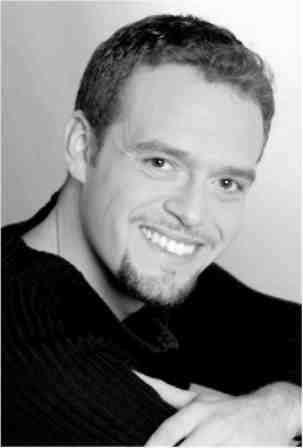
RAFAEL ORTIZ / El capitán Centellas
Licenciado por la universidad de Kent at Canterbury en el año 2001. Formación: Interpretación con Cicely Berry. Interpretación con Will Keen. Interpretación en el universo Shakesperiano con Owen Horsley. Integrado en el proyecto de la Joven Compañía Nacional de Teatro Clásico recibe formación con Vicente Fuentes, Carlos Aladro o Helena Pimenta, participando en los montajes de la Joven Compañía Nacional de Teatro Clásico.
TEATRO
LAS BIZARRÍAS DE BELISA. Lope de Vega. Dirección Eduardo Vasco (2007). Producción Compañía
Nacional de Teatro Clásico.
LA NOCHE DE SAN JUAN. Lope de Vega. Dirección Helena Pimenta (2008). Producción Compañía
Nacional de Teatro Clásico.
DE CUANDO ACÁ NOS VINO. Lope de Vega. Dirección Rafael Rodríguez (2010). Producción
Compañía Nacional de Teatro Clásico.
EL PERRO DEL HORTELANO. Lope de Vega. Dirección Eduardo Vasco (2011) Producción Compañía
Nacional de Teatro Clásico
EL ALCALDE ZALAMEA. Lope de Vega. Dirección Eduardo Vasco (2012) Producción Compañía
Nacional de Teatro Clásico.
En todos estos títulos participa como actor en la exhibición en Madrid, gira por España, Festivales
nacionales e internacionales o gira internacional
EL AVARO. Molière. Dirección Jorge Lavelli. Producción Centro Dramático Nacional
LOS JUSTOS. Albert Camus. Dirección Javier Hernández‐Simón. Producción Compañía 611 Teatro
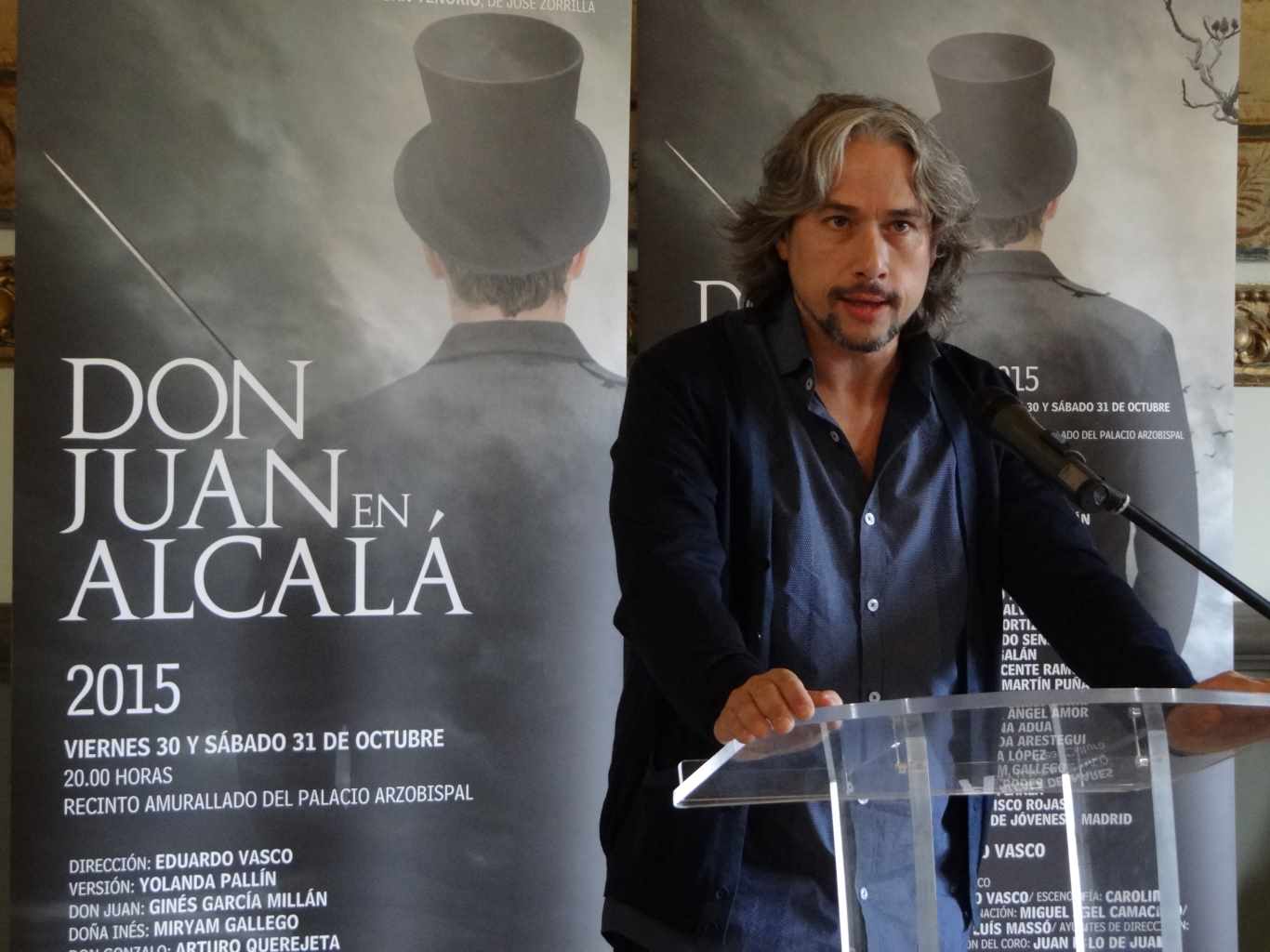
FERNANDO SENDINO/ Don Luis Mejía
TELEVISIÓN
Video & Games (presentador) Al salir de clase (reparto) El Comisario. Hospital Central. Los Ochenta. Isabel I y II
TEATRO (selección de trabajos realizados)
Compañía Nacional de Teatro Clásico.
La dama boba de Lope de Vega (2002) Dir. Helena Pimenta
El castigo sin Venganza de Lope de Vega (2005) Dir. Eduardo Vasco
Tragicomedia de Don Duardos de Gil Vicente (2006) Dir. Ana Zamora
El curioso impertinente Guillén de Castro (2006) Dir. Natalia Menéndez
El pintor de su deshonra de Calderón de la Barca (2009) Dir. Eduardo Vasco
La estrella de Sevilla de Lope de Vega (2009) Dir. Eduardo Vasco
Un bobo hace ciento de Antonio de Solís (2010) Dir. Pérez de la Fuente
Entremeses barrocos de Calderón de la Barca… (2011) Varios directores
Compañía Noviembre. Director Eduardo Vasco:
Final de partida de S. Beckett (1996)
No son todos ruiseñores de Lope de Vega (2000)
La bella Aurora de Lope de Vega (2003)
Hamlet de William Shakespeare (2004)
Don Juan Tenorio de José Zorrilla (2005)
Noche de reyes de William Shakespeare (2012)
Otelo de William Shakespeare (2013)
El Mercader de Venecia de William Shakespeare (2014)
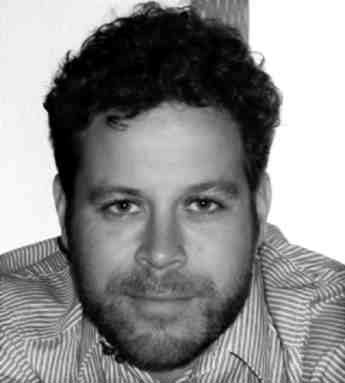
ÁNGEL GALÁN/ Gastón
Músico de escena, pianista y compositor.
Titulado Superior por el Conservatorio Superior de Música de Salamanca. Diplomado en
Magisterio en la especialidad de Música por la Universidad de Salamanca.
MÚSICO DE ESCENA
Músico de escena en los montajes de la Compañía Nacional de Teatro Clásico de 2005 a 2012:
“El Castigo sin venganza”. Lope de Vega. Dirección Eduardo Vasco. 2005
“La Tragicomedia de Don Duardos”. Gil Vicente. Dirección Ana Zamora. 2006
“Los Romances del Cid” versión de Ignacio García May y Eduardo Vasco. Dirección Eduardo Vasco.
2007
Seleccionado para formar parte del elenco artístico de la Joven Compañía Nacional de Teatro
Clásico, participa en los montajes:
“Las Bizarrías de Belisa” de Lope de Vega. Dirección Eduardo Vasco. 2008
“La noche de San Juan” de Lope de Vega. Dirección Helena Pimenta. 2009
“La moza de cántaro” de Lope de Vega. Dirección Eduardo Vasco 2010
“Todo es enredos, amor” de . Dirección Álvaro Lavín 2011
“Entremeses Barrocos” codirigida por Pilar Valenciano, Elisa Marinas, Aitana Galán y Héctor del Saz. 2012
“La Gaviota” de Anton Chejov. Dirección Eduardo Vasco. Producción de Teatres de la Generalitat. 2011
“Noche de reyes” de William Shakespeare. Dirección Eduardo Vasco. Producción Noviembre Compañía de Teatro. 2012‐2013
“Otelo” de William Shakespeare. Dirección Eduardo Vasco. Producción Noviembre Compañía de Teatro. 2013‐2014
COMPOSITOR Y DISEÑADOR DE ESPACIOS SONOROS PARA LA ESCENA
“Entremeses Barrocos” codirigida por Pilar Valenciano, Elisa Marinas, Aitana
Galán y Héctor del Saz. 2012. Firma la composición original y la dirección musical
“El Malentendido” de Albert Camus. Dirección Eduardo Vasco. Producción Centro Dramático Nacional. 2012
“Hedda Gabler” de Henri Ibsen. Dirección Eduardo Vasco. Producción Centro Dramático Nacional. 2015
DOCENCIA
Compagina su labor artística con la docente.
Profesor de piano del Conservatorio Profesional de Música Pedro Aranaz de Cuenca.
JOSÉ VICENTE RAMOS/ Pascual
Diplomado en la Escuela de Arte Dramático de Cristina Rota, 1995‐1999
Cursos de Interpretación con Will Keen, 2011, Verso con Vicente Fuentes, 2004‐2014,
Interpretación con Denis Rafter, 2001, e Interpretación con John Strasberg, 1996
Cursos de Voz con Omar Rossi y Canto con Julio Pardo, del Teatro de la Zarzuela, 2002‐2003
Taller Preparación al casting con Andrés Cuenca, Azarte, 2011
Taller Hacia el objetivo con Sara Bilbatúa, La Central, 2012
Taller Claves de época para Cine y TV con Juan León, La Central, 2013
TEATRO (selección de trabajos)
En el Teatro de la Zarzuela
Carmen, de Bizet. Dir. escénica Ana Zamora y dir. musical Yi‐Chen Lin. Personaje: Curro Flores. 2014.
En la Compañía Nacional de Teatro Clásico:
Farsas y Églogas, de Lucas Fernández. Dir. Ana Zamora, 2012‐2014. Coproducción con Nao d’Amores.
Entremeses Barrocos, de Agustín Moreto. Dir. Aitana Galán, 2011‐2012
Un bobo hace ciento, de Antonio de Solís y Rivadeneyra. Dir. Juan Carlos Pérez de la Fuente, 2011
El condenado por desconfiado, de Tirso de Molina. Dir. Carlos Aladro, 2010
La Estrella de Sevilla, atribuida a Lope de Vega. Dir. Eduardo Vasco, 2009
El pintor de su deshonra, de Calderón de la Barca. Dir. Eduardo Vasco, 2008
El curioso impertinente, de Guillén de Castro. Dir. Natalia Menéndez, 2007
Tragicomedia de D. Duardos, de Gil Vicente. Dir. Ana Zamora, 2006
El castigo sin venganza, de Lope de Vega. Dir. Eduardo Vasco, 2005
Juan Tenorio, de José Zorrilla. Dir. Eduardo Vasco, 2000
En Noviembre Cía. Teatro
Hamlet, de Shakespeare. Dir. Eduardo Vasco, 2004
La bella Aurora, de Lope de Vega. Dir. Eduardo Vasco, 2003
La fuerza lastimosa, de Lope de Vega. Dir. Eduardo Vasco, 2002
En Nao d’Amores
El Auto de la Sibila Casandra, de Gil Vicente. Dir. Ana Zamora, 2003
Comedia llamada Metamorfosea, de Joaquín Romero de Cepeda. Dir. Ana Zamora, 2001
En Teatro Gasteiz
Aquí no paga nadie, de Dario Fo. Dir. Carlos Gil, 1994
Gernika. Un grito, de Ignacio Amestoy. Dir. Carlos Gil, 1993
Pasionaria ¡No pasarán!, de Ignacio Amestoy. Dir. Salvador Távora, 1991
Otros
Zona 0. Dir. Julián Quintanilla, Madrid Escena Contemporánea, 2002
Camino de Wolokolamsk, de Heiner Müller, Dir. Yolanda Mancebo, RESAD, 2001
Entre aquí y allá, de Victoria Szpunberg, Dir. Julián Quintanilla, RESAD, 2000
Limones de Sicilia, de Luigi Pirandello, Dir. Julián Quintanilla, RESAD, 1999
Estela, creación colectiva. Dir. Cristina Rota, 1999
El Gran Día de la Madre. Dir. Julián Quintanilla. Ayudante de dirección. 2014
CINE Y TELEVISIÓN (selección de trabajos)
Televisión
Águila Roja. Ep. 63, 2012. Personaje episódico.
Lobos. Temporada 1 Ep. 7, 2005. Personaje episódico.
Un lugar en el mundo. Temporada 1 Ep.6, 2003. Personaje episódico.
Hospital Central. Temporada 3 Ep. 1, 2002. Personaje episódico.
Cortometrajes
Participación en varios cortometrajes dirigidos por Jacobo Rispa entre los años 1996 y 1998
Largometrajes
El asombroso mundo de Borjamari y Pocholo. 2004. Dir. J. Cavestany y E.López Lavigne. Vigilante 2
No debes estar aquí. Dir. Jacobo Rispa. 2002. Celador
LOCUCIÓN
Locución de «Un médico rural«, de Franz Kafka para, Literatura Sonora http://www.literaturasonora.es/obra/un‐medico‐rural/
CRISTINA ADUA/ Doña Ana de Pantoja
Curso de Interpretación ante la cámara impartido por Eva Lesmes en La Central de Cine/ 2014RESAD 2008‐2012 Interpretación textual
Curso de Verso impartido por Vicente Fuentes/ 2013
Curso de Chéjov y las acciones físicas impartido por Mariano Gracia en el Laboratorio Layton/2011
Esgrima / Patinaje artístico/ Danza clásica y española/ Danza del vientre
TEATRO
“No esconderás un cadáver en el armario” con Estamos en ello dirigida por Xavi Fontana en el papel de Olivia/ 2015
“El mercader de Venecia” con Noviembre Teatro dirigido por Eduardo Vasco en el papel de Yéssica/ 2015
“Otelo” de Shakespeare con Noviembre Teatro dirigido por Eduardo Vasco en el papel de Desdémona/ 2015
“Tres hermanas” de A.Chéjov como Masha dirigido por Jesús Salgado/ 2013
“El vergonzoso en palacio” de Tirso de Molina como Magdalena dirigido por Yolanda Porras/ 2012
“Tiempo de fiesta” de H.Pinter como Dusty dirigido por Yolanda Porras/ 2012
“Todo lo que imagines” Musical Infantil dirigido por Carlos Hermay/ 2012
“California Suite” de Neil Simon como Diana dirigido por Jesús Salgado/ 2011
“La gaviota” de A.Chéjov como Nina dirigido por Jesús Salgado/ 2011
“La corista” de A.Chéjov como Pasha dirigido por Jesús Salgado/ 2010
“El sueño de una noche de verano” de W.Shakespeare como Helena dirigido por Rosa Gavara/ 2009
“Alicia en el país de las maravillas” de L.Carrol como Alicia dirigido por Rosa Gavara/ 2009
LORENA LÓPEZ/ Lucía
Talleres de improvisación, composición e investigación con: María Muñoz y Pep Ramis (Cia. Mal pelo), Mónica Valenciano, Lipi Hernández (Cia. Las Malqueridas), Jean Laurent‐Sasportes (Cia. Pina Bausch), Will Swanson, Africa Navarro, Ana Extremiana, Rocío Pérez, Santiago Sempere, Marian del Valle, entre otros…Titulada en danza contemporánea, Conservatorio profesional de danza de Valencia (2004) Seminarios de Interpretación y Técnica Vocal. Formación: Permission playground. Método Trhuth con Jordane Bayne ; Entrenamiento para Cine y TV con Bob Mcandrew; Entrenamiento para actores con Fernando Piernas; Comedia para CINE y TV, con Eva Lesmes; La construcción del personaje, con Ramón Salazar; De la impresión a la expresión, con Marta Belenguer; Actor cuerpo y sentido con, José Juan Rodríguez y Pablo Guevara; Prácticas escénicas con textos de A. Chèjov, impartido por Joaquim Candeias; La búsqueda de la presencia y la expresión física y vocal, con Isabel Úbeda; Expresión vocal, con Nuria Inglada; Curso de técnica Alexander con Tonni Tacher; Curso de Skiner ralesing‐Tecnique, con DD Dorvillier; Curso de Body‐weather, con Carme Torrent.
TEATRO
“A España no la va a conocer ni la madre que la parió” de Lucía Carballal y Victor Sánchez.
Dirirección Victor Sánchez. 2015
“El Mercader de Venecia” de William Shakespeare. Dirección. Eduardo Vasco Cia. Noviembre
Teatro 2015
“Yernos que aman” escrita y dirigida por Abel Zamora. 2015
“Otelo” de William Shakespeare. Dirección. Eduardo Vasco. Cia. Noviembre Teatro. 2014
“Anfitrión” de Moliére/Plauto. Dirección: Eduardo Vasco. Producción de Culturarts GV. 2014
“Temporada baja” de Abel Zamora. Dirección: Sergio Caballero. Producción de Culturarts GV.
2013
“A lo panenka” de Rafael Ponce. Dirección. Rafael Ponce. Cia. Los teloneros. 2013
“La Gente” de Juli Disla. Dirección: Jaime Pérez. Cia. Pérez&Disla. 2012. Finalista en los Premios
Max como mejor autoría revelación.
“El Rey Lear” de William Shakespeare. Producción Teatres de la Generalitat Valenciana. Dirección:
Ximo Flores, 2012
“Expuestos” de Juli Disla. Cia. Pérez&Disla. Dirección: Jaime Pérez. 2011
“Los locos de valencia” de Lope de Vega. Dirección: Antonio Tordera. Producción Teatres de la
Generalitat Valenciana. 2011
“Todas muertas” Texto y dirección Abel Zamora. Cia. Oscura Teatre. 2011
“Mi camiseta, sus zapatilla, tus vaqueros” Texto y dirección Gabriel Ochoa producción del Festival VEO. 2010
“La ràbia que em fas” de Juli Disla. Dirección: Jaume Pérez. Producción de Teatres de la
Generalitat. Valenciana 2009
“Yo os declaro…” Texto y dirección: Eva Zapico. Cia. Copia Izquierda. 2009
“Invisible” de Eduardo Zamanillo. Cia. PTV Clowns. 2007‐2009
“Rip, Rip, Hurra” Dirección: Rafael Ponce Cia. ESTEVE Y PONCE. 2004
DANZA
“Boyfriend”. Cia. LA CABRA. Dirección:Valeria Alonso. Estreno en el Certamen Coreográfico de Madrid. 2007
“Carácter Mediterrani”, Cia. Bambalina. Dirección: Jaume Policarpo. 2006
“Deslunados” Cia. CEL RAS. Festival VEO. Dirección: Rocío Pérez, Colaboración en la dirección:Jordi Cortés (Cia. DV8 Physical Theater) y Mónica Extremiana. 2006
“Soledades” Cia. LOSQUEQUEDAN. Dirección: Sandra Gómez y Vicente Arlandis. 2005
“Nada”, “Martes” y “Recién peinadas”. Dirección: Meritxell Barberá e Inma García. Cia. TAIAT DANSA . 2002‐2003
CINE Y TELEVISIÓN
“Prendas Delicadas” Dirección: Miguel Ángel Marcos (cortometraje) 2013
“La Buena Fe” Dirección: Begoña Soler. (cortometraje) 2013
“El amor ya no es lo que era” Dirección: Gabriel Ochoa. TV ON producciones. 2012
“L’Alquería blanca” Producción Trivisión y Zenit para Canal 9. 2010‐2011
“Recreo” Dirección: Juan Pablo Báez. Claroscuro producciones. 2011
“Jardines humanos” Dirección: Juan Pablo Báez. Claroscuro producciones (cortometraje) 2011
“Ángela” (Cortometraje en 3D) Dirección: Alberto Gonzalez y Carlos P. Santa Maria 2010
“Maquillaje” Dirección: Álex Montoya (cortometraje) 2010
“5 metros cuadrados” Dirección: Max Lemcke. Aliwood producciones (largometraje) 2010
“Mi camiseta, sus zapatillas, tus vaqueros” (largometraje producido por Festival VEO 2010)
Dirección: Gabi Ochoa 2010
PREMIOS
Premio mejor actriz – por « Jardines humanos » Festival cortocomenius. 2012
Premio Mejor Actriz – por “Recreo” Festival Corto Comenius. 2011
Nominación Mejor Actriz – por “Todas Muertas” Premios AAPV (asociación de actores y actrices
profesionales de Valencia). 2011
Nominación Mejor Actriz‐ por « La Ràbia que em fás » premios Teatres de la Generalitat. 2011
Premio Actriz revelación, por La Ràbia que em fás / Premios de la AAPV (asociación de actores y
actrices profesionales de Valencia) 2010
Premio ABRIL ‐ Mejor Actriz de reparto por La ràbia que em fás 2010
HELENA LANZAS/ La Tornera de las Calatravas de Sevilla
Escola Superior Teatro e Cinema de Lisboa (Teatro, performance y cine) 2011‐2012Licenciada en interpretación textual por la RESAD (2009/2013)
Verso con Karmele Aramburu (2015)
Academia del Verso de Alcalá con Yayo Cáceres y Álvaro Tato (Ron Lalá) (2015)
Taller de “Medea” con Andrés Lima .Miembro del coro .Teatro de la ciudad (Teatro de la Abadía)
(2015)
Taller de interpretación “La cualidad” con Andrés Lima (2014)
Taller de interpretación con Josep María Mestres (2014)
Entrenamiento actoral con La Joven Compañía Dir: José Luis Arellano (2014)
Taller de la palabra con José Luis Gómez, Ernesto Arias y Vicente Fuentes. Teatro de la Abadía (2014)
Taller de creación escénica en movimiento con David Espinosa (2013)
Laboratorio de creación “Vivero” con José Pedro Carrión (2012‐2013)
Lectura dramatizada de poemas en voz altacon Eduardo Fuentes (2012‐2013)
Entrenamiento actoral. José Carlos Plaza .Azarte .Madrid (2011)
Técnica Michael Chéjov .Mariano Gracia. Laboratorio William Layton. Madrid (2011)
Master Class Claudio Tolcachir. Naves del Matadero del Teatro Español. Madrid (2011)
Composición de personajes ante la cámara. Macarena Pombo. Central de Cine. Madrid (2010)
Bufonescon Andrés del Bosque (2009‐2010)
El cuerpo: mapa y paisaje. Denise Perdikidis. Formación contínua. Laboratorio W. Layton.
Laboratorio William Layton con Begoña Valle, ArnoldTaraborrelli y Chelo García. (2009)
Clown. Gabriel Chamé. Laboratorio William Layton. Madrid (2008)
Taller de creación escénica con Juan Loriente y Alberto Jiménez (2008)
TEATRO
Romeo y Julieteta de Alfredo Sanzol . Teatro de la Ciudad (Andrés Lima, Miguel del Arco y
Alfredo Sanzol).Teatro de la Abadía (2015)
La comedia de los errores de William Shakespeare .Dir: Lidio Sánchez‐Caro (2015)
La herida del tiempo de J.B Priestley .Dir: Vicente Rodado (2015)
La ola de Ignacio García May. Dir: Marc Montserrat Drukker CDN (2014‐2015)
Los desvaríos del veraneo de Goldoni. Dir : José Gómez Cía: Venezia Teatro (2014)
Poesía en el Corral: Tres poetas jóvenes. Dir e interpretación: Helena Lanza y Alberto Alonso
(2014)
Los cuatro de Düsseldorf de José Padilla. (2014)
La casa de Bernarda Alba. Dir: Alberto Alonso. II Premio Certamen Jóvenes Creadores Madrid
(2014)
El salto de Léucadede Alicia Casado Dir: Pedro Entrena (2014)
Fuego Fatuo de Pedro Entrena. Finalista Certamen Jóvenes Creadores Madrid (2014)
Don Juan en Alcalá Versión: Ronald Brouwer y Carlos Aladro. Dir: Carlos Aladro (2013)
El valor de las mujeres de Lope de Vega. Versión y Dir: Íñigo Rodríguez‐Claro (2013)
LeviathanCía Living Structures.Dir: Klaus Kruse. Naves del Matadero del Teatro Español (2012)
Edifícioautor.Dir: J.P Bucchieri. Teatro Nacional D.Maria II. Lisboa (2012)
El sueño de una noche de verano adaptación de José Padilla. Dir: Íñigo Rodríguez‐Claro (2011)
La niña de plata de Lope de Vega. Dir: Ernesto Filardi. Nominación premios MAYTE 2010. Las
huellas de la Barraca, MCU, SECC. Festival de
Almagro. Corral de Comedias de Alcalá de Henares (2010)
La Democracia Dir: Pablo Fidalgo y Estefanía Gómez. Aula de Danza UAH (2009)
AUDIOVISIAL
Carpe Diem de Rubén Trujillo .Dir: David Díaz (2013). NOTODOFILMFEST.
ChangingEarthie International Workshop WanseeForum (Berlín 2012)
Cuarto Milenio, capítulo: Ánimas Benditas. Recreación histórica. Canal 4.Plural entertainment
(2010)
FRANCISCO ROJAS/ Un Escultor
TEATRO
Licenciado en Interpretación por la Real Escuela Superior de Arte Dramático de Madrid. Curso de perfeccionamiento actoral en el Teatro de la Abadía. Cursos de verso de Vicente Fuentes y Josefina Aráiz.
«Orquesta de Señoritas» de Jean Anouilh. Pérez de la Fuente Producciones. Versión y dirección:
Juan Carlos Pérez de la Fuente.
«Entremeses barrocos» de diversos autores. Compañía Nacional de Teatro Clásico. Versión: Luis
García Araús. Dirección: Pilar Valenciano, Elisa Marinas, Aitana Galán y Hector del Saz.
«Un bobo hace ciento» de Antonio de Solís y Rivadeneira. CNTC. Versión: Bernardo Sánchez Salas.
Dirección: Juan Carlos Pérez de la Fuente.
«El Condenado por desconfiado» de Tirso de Molina. CNTC. Versión: Yolanda Pallín. Dirección:
Carlos Aladro.
«La Estrella de Sevilla», atribuida a Lope de Vega. CNTC. Versión y dirección: Eduardo Vasco.
«Auto de los Reyes Magos». Anónimo. Nao d´Amores. Versión y dirección: Ana Zamora.
«Romances del Cid». CNTC. Versión: Ignacio García May. Dirección: Eduardo Vasco.
«El Curioso Impertinente» de Guillem de Castro. CNTC. Dirección: Natalia Menéndez.
«Viaje del Parnaso» de Miguel de Cervantes. CNTC. Versión: Ignacio García May. Dirección:
Eduardo Vasco.
«Amar después de la muerte» de Calderón de la Barca. CNTC. Dirección: Eduardo Vasco.
«Hamlet» de William Shakespeare. Noviembre Cía. de Teatro. Dirección: Eduardo Vasco.
«Animales nocturnos» de Juan Mayorga. Escena Abierta. Dirección: Juan Pastor.
«Auto de la Sibila Casandra» de Gil Vicente. Nao d´Amores. Dirección: Ana Zamora.
«La bella Aurora» de Lope de Vega. Noviembre Cía. de Teatro. Versión y dirección: Eduardo Vasco.
«Peribáñez y el comendador de Ocaña» de Lope de Vega. CNTC. Dirección: José Luis Alonso de
Santos.
«Un ligero malestar» de Harold Pinter. Dirección: Juan Antonio Codina.
«Dom Juan o el festín de piedra» de Molière. CNTC. Dirección: Jean‐Pierre Miquel.
«Madrugada» de Buero Vallejo. Cía. de Comedias Manuel de Blas. Dirección: Manuel de Blas.
«No son todos ruiseñores» de Lope de Vega. Noviembre Cía. de Teatro. Versión: Yolanda Pallín.
Dirección: Eduardo Vasco.
«Los amores de Anatol» de Arthur Schnitzler. Dirección: Luis d´Ors y Tomás Muñoz.
«Androcles y el león» de Bernard Shaw. Dirección: José Pascual.
«Aquí necesitamos desesperadamente una terapia» de Christopher Durang. Cía. Maite Merino.
Dirección: Charo Amador.
«Los motivos de Anselmo Fuentes» de Yolanda Pallín. Noviembre Cía. de Teatro. Dirección:
Eduardo Vasco.
«Por delante y por detrás» de Michael Frayn. Seoane Producciones. Dirección: Alexander Herold.
«Cádiz», zarzuela en dos actos de Chueca y Valverde. Producción Teatro de Madrid. Dirección:
Gustavo Tambascio.
«Noche de Reyes» de William Shakespeare. Joven Escena. Dirección: Juan Pastor.
«La Celestina» de Fernando de Rojas. FOCUS. Dirección: Hermann Bonnin.
«Los mal casados de Valencia» de Guillem de Castro. CNTC y Teatres de la Generalitat Valenciana.
Dirección: Luis Blat.
«Fuenteovejuna» de Lope de Vega. CNTC. Dirección: Adolfo Marsillach.
«La Gran Sultana» de Miguel de Cervantes. CNTC. Dirección: Adolfo Marsillach.
«El castillo de Lindabridis» de Calderón de la Barca. Joven Escena. Versión y dirección: Juan
Pastor.
«El Amor enamorado» de Lope de Vega. RESAD. Dirección: Vicente Fuentes.
«Ensueño» de August Strindberg. RESAD. Dirección: Juan Pastor.
PROFESOR Y ASESOR DE VERSO
Asesor de verso en la Compañía Nacional de Teatro Clásico y en la compañía canaria 2RC, en varios montajes, a destacar: «La Verdad Sospechosa» de Ruiz de Alarcón, «El Castigo sin Venganza» de Lope de Vega, «El Perro del Hortelano» de Lope de Vega, «Amar después de la muerte» de Calderón de la Barca, «Viaje del Parnaso» de Miguel de Cervantes, «Don Duardos» de Gil Vicente, «El Alcalde de Zalamea» de Calderón de la Barca, «Sainetes» de Ramón de la Cruz, «Abre el ojo» de Rojas Zorrilla.
MARTÍN PUÑAL/ Alguacil uno
Academia del verso de Alcalá, 2015. Con Ron LaláTaller de formación y selección Joven Compañía Nacional de Teatro Clásico, 2015
Estudios de Arte dramático con Tamzin Townsend, 2013
Taller de formación y selección Joven Compañía Nacional de Teatro Clásico, 2012
Estudios de Arte Dramático en Laboratorio de teatro William Layton, 2012
Academia del verso de Alcalá, 2011. Con KarmeleAranburu y Juan Polanco
Especialidades: Equitación, canto (tenor y contratenor)
TEATRO
Oscura raíz del grito, autores varios. Dirección Yayo Cáceres Ron Lalá. Personaje Don Alonso
Caballero de Olmedo. Producido por Academia del verso de Alcalá
#Microalcaláy #Microhenares. Actor y director de proyecto. Producido por Ayuntamiento de
Alcalá de Henares y Ayuntamiento de Azuqueca de Henares (XXXII Festival La espiga de Oro)
Don Juan en Alcalá XXX Aniversario, de José Zorrilla. Dirección Carlos Aladro. Personaje Buttarelli.
Producido por Ayuntamiento Alcalá de Henares, Clara Pérez Distribución y la Compañía Tío
Venancio. 2014. Alcalá de Henares.
Deseada, de Eduardo Marquina. Dirección Artes Verbénicas. Personaje Manuel. Producido por la
Compañía Tío Venancio y Artes Verbénicas. 2014‐2015. Alcalá de Henares y Madrid.
Contagiados, comedia musical de Martín Puñal y Yashmín Zamani. Personaje protagonista.
Producido por Cía Tío Venancio. 2013‐2015. Gira España
El caballero de Olmedo, de Lope de Vega. Dirección Nancho Novo. Personaje Tello. Producido por
Microteatro por Dinero. 2013. Festival Internacional de Almagro
Clásicos a la carta, autores varios. Idea original Martín Puñal, Marina Blanco y Luis Tausía.
Producido por Es.Arte. 2013‐2015. Festival de Olite, Festival de Somontano, Feria Internacional de
Ciudad Rodrigo, Festival de teatro de calle de Getafe y Clásicos en Alcalá
Don Juan en Alcalá, de José Zorrilla. Dirección Jorge Muñoz. Personaje Capitán Centellas.
Producido por ayuntamiento Alcalá de Henares y Es.Arte. Alcalá de Henares
La discreta enamorada & Doña Francisquita de Lope de Vega. Dirección Juan Polanco. Personaje
Hernando. Produce Academia del verso y Clásicos en Alcalá. 2012. Alcalá de Henares
La última noche. Dirección y dramaturgia Jazz Vilá. Personaje protagonista. Producido por Garaje
Lumiére. 2012. Madrid
XX > XY. Dirección y dramaturgia Nancho Novo. Personaje protagonista. Producido por
Microteatro por Dinero. 2012. Madrid
El primer perro del mundo, musical familiar. Dirección y dramaturgia Daniel Pérez. Personaje
protagonista. Producido por Es.Arte. 2011‐15. Gira España
Los empeños de una casa, de Sor Juana Inés de la Cruz. Dirección Juan Polanco. Personaje
Hernando. Producido por Academia del verso y Clásicos en Alcalá. Festival Internacional de
Almagro y Clásicos en Alcalá
Las noches de Don Juan en Alcalá, de José Zorrilla. Personaje Don Luis Mejía. Producido por
Cervantalia y Turismo de Alcalá. 2009 al 2014. Ruta teatralizada Alcalá de Henares
Don Juan en Alcalá, de José Zorrilla. Dirección Juan Polanco. Personaje Alguacil. Producido por
Ayuntamiento de Alcalá de Henares y Es.Arte
Un crimen en el cielo. Dirección y dramaturgia. Nancho Novo. Personaje San Pancracio. Producido
por Cía Tío Venancio. 2009‐2010. Alcalá de Henares
Don Juan en Alcalá, de José Zorrilla. Dirección Laila Ripoll. Producido Por Ayuntamiento de Alcalá
de Henares. 2008
Don Juan en Alcalá de José Zorrilla. Dirección Santiago Sánchez L’OM Imprèbis. Producido por
Ayuntamiento de Alcalá de Henares. 2007
CINE Y TELEVISIÓN
TELEVISIÓN
Física o química. Producido por Ida y Vuelta. Antena 3. 2009. Personaje episódico
Cuéntame cómo pasó. Producido por Ganga Producciones. TVE. 2009 y 2010. Personajes
episódicos.
Tres días de Abril. Producido para TVE. 2010. Personaje Infante Gonzalo de Borbón
CINE
El manuscrito Vindel. Dirección José Manuel Fernández‐Jardón Vindel y Luis Fernández‐Jardón.
Personaje Pedro Vindel, co‐protagonista
El futuro. Dirección Luis López Carrasco. 2012
OTRAS ACTIVIDADES
#MICROHENARES. Director de proyecto. 2015. Producido por Ayuntamiento de Azuqueca de
Henares para la XXXII Festival La Espiga de Oro
#MICROALCALÁ, Director de proyecto. 2015. Producido por Ayuntamiento de Alcalá de Henares
Organización ruta teatralizada para Alcalá de Henares con la producción de World Business
Travel. 2015
Contratación actores XXX Aniversario Don Juan en Alcalá. 2014
Producción ejecutiva montaje Deseada de la compañía Artes Verbénicas. 2014‐2015
Coordinador figuración Don Juan en Alcalá. 2010‐12‐13‐14
MIGUEL ÁNGEL AMOR/ Alguacil dos
Licenciado en Arte Dramático, especialidad interpretación textual. Escuela Superior de Arte
Dramático, 2010 (Sevilla, España).
Máster en Artes Escénicas. Universidad Rey Juan Carlos I, 2012 (Madrid, España).
La palabra en los textos de Shakespeare. Impartido por WillKeen. Madrid. 2015.
Versos. Fundación Siglo de Oro. Impartido por Jesús Fuente. Madrid. 2013
Máscara Neutra. Impartido por Mar Navarro. Taller intensivo. Madrid. 2011
Entrenamiento Técnica Chéjov. Escuela Juan Codina. Impartido por Lidia Otón. Madrid. 2014.
Pasiones, estados dramáticos y emociones. Impartido por Mar Navarro y Andrés Hernández.
Taller intensivo. Madrid. 2012.
Entrenamiento vocal. Impartido por Celia Guisasola. Madrid. 2015
Técnicas de cine y televisión. Centro Actúa de AISGE. Impartido por Gracias Querejeta. Madrid. 2015.
Herramientas para cine y televisión. Central de cine. Impartido por Eva Lesmes. Madrid. 2012.
Entrenamiento ante la cámara. Central de cine. Impartido por Macarena Pombo. Madrid. 2012.
Equitación. Centro Ecupasil. Impartido por Jose Luis Serra. Cáceres. 2013.
Esgrima escénica. Escuela Superior de Arte Dramático. Impartido por Amparo Ruiz. Sevilla. 2009.
Flamenco (danza). Escuela Superior de Arte Dramático. Impartido por Francisca Murillo. Sevilla. 2009.
TEATRO
Los perros no van al cielo, Laura Rubio Galletero. Dirección Oscar Miranda. Personaje: Pedro. Producido por SGAE dentro del Ciclo de lecturas dramatizadas El Teatro Se Lee En La Berlanga. 2015.
Doble, José Fernández. Dirección José Luis Verguizas. Personaje: Hermano. Producido por ArteDeFacto Producciones, 2015.
Fidelio, Beethoven. Dirección Pier’Alli. Personaje: soldado. Producido por Teatro Real, 2015.
El infierno son los otros, adaptación de “A puerta cerrada” de Jean Paul Sartre. Dirección José Luis Verguizas. Personaje: Botones. Producido por ArteDeFacto Producciones, 2014.
Alceste, Gluck. Dirección KrzysztofWarlikowski. Personaje: coro bailarines. Producido por Teatro Real. 2014.
The Indian Queen, Purcell. Dirección Peter Sellars. Personaje: militar. Producido por Teatro Real. 2013.
Esperando a Godot, Samuel Beckett. Dirección Alfredo Sanzol. Personaje: muchacho. Producido por Centro Dramático Nacional, 2013.
Omphalofobia, Laura Rubio Galletero. Dirección Laura Rubio Galletero. Personaje: Él. Madrid. 2013.
Luna de Mielda, Juan García Larrondo. Dirección Alfonso Zurro. Personaje: El novio. Producido por Teatro de Hotel. Sevilla. 2010.
Bodas de Sangre, adaptación de Salvador Távora sobre el texto de Federico García Lorca. Dirección Concha Távora. Personaje: El novio. Sevilla. 2010.
Los amantes de Teruel, Juan Peréz de Montalbán. Dirección Omero Cruz. Personaje: Don Diego. Producido por ESAD de Sevilla. Teatro Central. 2009.
TELEVISIÓN
Episódicos.
Hispania, La leyenda. Dirección Alberto Rodriguez, producido por Bambú Producciones, antena 3, 2010.
Capítulo 4. Personaje: suboficial romano.
Vista pública. Producido por Medina Media SL, Canal Sur, 2007. Personaje: enfermero.
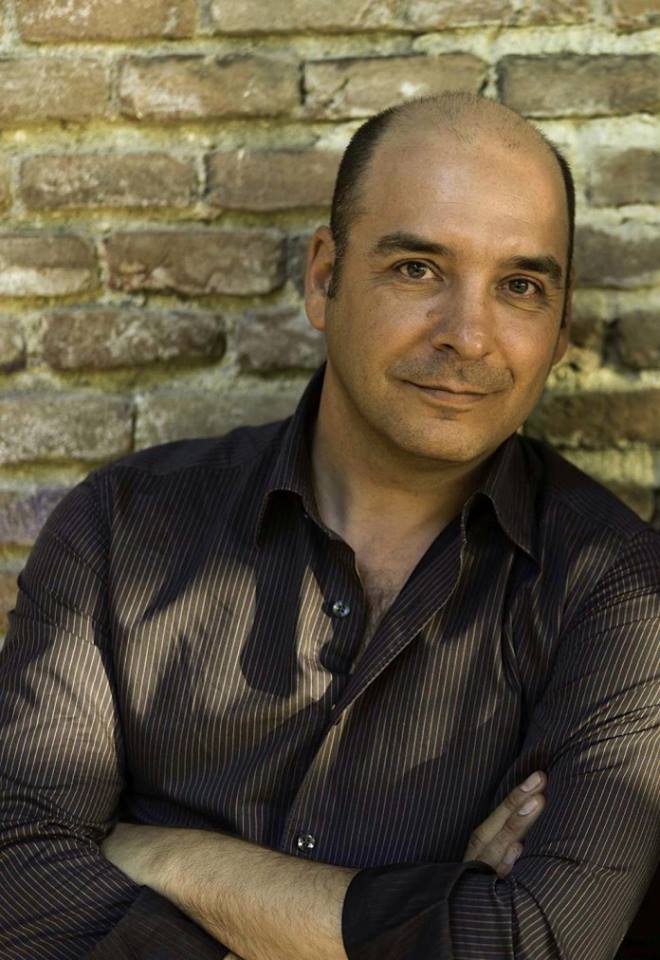
EDUARDO VASCO (Dirección)
Es licenciado en Interpretación (1990) y Dirección Escénica (1996) por la Real Escuela Superior de Arte Dramático de Madrid. Curso sobre La puesta en escena de la ópera. Estudios de dirección escénica en la Regie Opleiding Theaterschool Amsterdam (Holanda) Curso Beckett Workshop impartido por Joe Chaikin (Open Theatre) en Das‐Arts (de Amsterdamse School Advance Research in Theatre and Dance Studies). Amplia formación como músico y especialista en espacio sonoro para teatro. Ha sido director de la Compañía Nacional de Teatro Clásico de 2004 a 2011. Ha trabajado como director de escena diferentes compañías entre las que destacan:
Noviembre Compañía de Teatro (1995‐2012)
Otelo, de Shakespeare. Noche de reyes de Shakespeare. Hamlet, de Shakespeare. La bella Aurora, de Lope de Vega. Algún amor que no mate, de Dulce Chacón. La fuerza lastimosa, de Lope de Vega. No son todos ruiseñores, de Lope de Vega. Dedos (Vodevil negro), de Borja Ortiz de Gondra. Los motivos de Anselmo Fuentes, de Yolanda Pallín. Lista Negra, de Yolanda Pallín. Final de Partida, de Samuel Beckett. Camino de Wolokolamsk, de Heiner Müller.
Compañía Nacional de Teatro Clásico (2000‐2011)
El Alcalde de Zalamea, de Calderón de la Barca. La moza de cántaro, de Lope de Vega. La estrella de Sevilla, de Lope de Vega. Las manos blancas no ofenden, de Calderón de la Barca. El pintor de su deshonra, de Calderón de la Barca. Las Bizarrías de Belisa, de Lope de Vega. Romances del Cid, en versión de Ignacio García May. Don Gil de las calzas verdes, de Tirso de Molina. Amar después de la muerte, de Calderón de la Barca. Viaje del Parnaso, de Miguel de Cervantes. El castigo sin venganza, de Lope de Vega. Don Juan Tenorio, de Zorrilla.
Centro Dramático Nacional
Rey Negro, de Ignacio del Moral (1997). Los vivos y los muertos, de Ignacio Ga May (2000). El malentendido de Albert Camus (2013). Hedda Gabler de Ibsen (2015)
Teatres de la Generalitat Valenciana
La gaviota de Chejov (2011), Anfitrión de Moliere / Plauto (2014)
Festival Mozart de Ópera de La Coruña
Il ré pastore de W. A. Mozart (2007)
MENCIONES Y PREMIOS
Encomienda de la orden del mérito civil concedida por S.M. el rey Juan Carlos I de España. Premio Fuente de Castalia 2014 Festival Clásicos de Alcalá. Dos Premios Florencio de la crítica uruguaya al mejor espectáculo extranjero por El alcalde de Zalamea (2012) y Don Gil de las calzas verdes (2008). Premio Teatro Rojas al mejor espectáculo y mejor dirección escénica temporada 2011‐ 2012 por El perro del hortelano y mejor espectáculo temporada 2008‐2009 por El pintor de su deshonra. En 1993 obtuvo el Premio José Luis Alonso para nuevos directores otorgado por la ADE, Premio Ágora 2000.
YOLANDA PALLÍN (Versión)
Licenciada en Arte Dramático (Interpretación) por la Real Escuela Superior de Arte Dramático deLicenciada en Filología Hispánica (Literatura) por la Universidad Complutense de Madrid (1989).
Madrid (1990)
Actualmente es profesora de la RESAD, en el departamento de Escritura y Ciencias Teatrales y
forma parte del Consejo de Lectura del CDN.
Ha estrenado con Noviembre Compañía de Teatro los textos: Lista Negra (1997) y Los motivos de
Anselmo Fuentes (1998), y las versiones de No son todos ruiseñores, de Lope de Vega (2000), La
fuerza lastimosa, de Lope de Vega (2002), Hamlet, de William Shakespeare (2004) y Otelo de
William Shakespeare (2013).
Con otras compañías ha estrenado Hiel, con Ateatro, que fue Premio José Luis Alonso al director
joven 1993 por la puesta en escena de Eduardo Vasco. Tierra de nadie (estrenada en Madrid y
Amsterdam en 1994). DNI y Como la vida misma (1995). Lista negra (1997) también bajo la
dirección de Eduardo Vasco Memoria, Luna de miel, Siete años, Entrevías y las tres piezas de la
Trilogía de la Juventud (Las manos, Imagina y 24/7) escritas junto a José Ramón Fernández y Javier Yagüe. Su último texto: So happy together, escrito junto a J.R. Fernández, Laila Ripoll y Jesús
Laíz.
Ha realizado adaptación de textos clásicos para la Compañía Nacional de Teatro Clásico como
Don Juan Tenorio, de Zorrilla (2000); La entretenida, de Cervantes; Amar después de la muerte,
de Calderón de la Barca; El curioso impertinente, de Guillén de Castro; La noche de San Juan, de
Lope de Vega; El condenado por desconfiado, de tirso de Molina. Con directores como Helena
Pimenta, Natalia Menéndez, Eduardo Vasco o Carlos Aladro. Ha adaptado otros textos clásicos
como Coriolano, de William Shakespeare y zarzuela como La gran vía de Felipe Pérez, ambos
dirigidos por Helena Pimenta.
Como autora teatral ha recibido el Premio Calderón de la Barca 1996 por su obra Los motivos de
Anselmo Fuentes, el Premio María Teresa de León 1995 por Los restos de la noche, y ese mismo
año fue Accésit al Premio Marqués de Bradomín con su obra La mirada. Ha recibido, además de
los mencionados, premios como Ojo Crítico de Teatro, Premio MAX al mejor autor
2001, Celestina al mejor autor, (Mejor espectáculo en la Feria de Teatro de Huesca, Mejor
espectáculo de la temporada 2000‐2001 de la crítica Teatral de Valencia, Mejor montaje de
Teatro 2001 de El País de las Tentaciones, Finalista del Premio Mayte de Teatro, dos veces
.Finalista del Premio MAX al mejor autor y Finalista del Premio Nacional de Literatura
Dramática.
Ha editado una antología de Entremeses de Juan Rana.
Coro de Jóvenes de Madrid
De reciente creación, una gran mayoría de sus componentes proceden del Coro de Jóvenes de la Comunidad de Madrid, coro que en sus 13 años de actividad, logró convertirse en uno de los coros juveniles de mayor importancia e interés, tanto a nivel local, como nacional, realizando conciertos y participando en certámenes corales en España y otros países europeos.El Coro de Jóvenes de Madrid es un proyecto humano y musical creado por la Asociación Juvenil Coro de Jóvenes de Madrid, en estrecha colaboración con Juan Pablo de Juan Martín, al cargo de la dirección artística.
HISTORIA
El Coro de Jóvenes de Madrid inició su aventura en Julio de 2014, pero aunque la fecha de su fundación es muy reciente, en realidad la andadura conjunta de este Coro y su director Juan Pablo de Juan es larga y se remonta cuatro años atrás, cuando cantantes y director formaban parte del Coro de Jóvenes de la Comunidad de Madrid, con el que consiguieron un amplio reconocimiento en el panorama coral internacional.
Decididos a crear su propio coro, se estrenan como invitados del Orfeoi Gazte, el coro joven del Orfeón Donostiarra, con un concierto conjunto en San Sebastián. Este concierto supuso el pistoletazo de salida de una gira internacional, con conciertos en la Iglesia de Saint Eustache de París, en Berlín, en Walstfischbach (Alemania), en la Iglesia de Santa María del Pí, en Barcelona, y la participación en el Festival 10th International‐Youth Chamber Choir Meeting en Usedom (Alemania), durante el cual el Coro ha tenido ocasión de trabajar con prestigiosos directores como Bo Johansson (Suecia), Ursa Lah (Eslovenia) y Kjetil Aamann (Noruega).
La Gira Internacional y la participación del Coro en el Festival de Usedom han sido protagonistas del Documental “Cantar para Vivir” de Guillermo Mealla (Madrid Films). El Coro se compone de 70 cantantes de entre 15 y 24 años, que pese a su juventud, son ya cantantes “veteranos”, puesto que además de su amplia trayectoria conjunta, muchos de ellos acumulan vivencias desde coros infantiles. Con la experiencia que otorga este bagaje, se ha conseguido forjar un coro con un amplio repertorio, que aborda obras de alta complejidad técnica y vocal con gran solvencia y rapidez.
Este nuevo camino supone para los chicos y chicas que forman el Coro de Jóvenes de Madrid, el sueño de vivir la música entre amigos, y la ilusión de conseguir que el público, especialmente el joven, participe con ellos de la magia de la música coral.


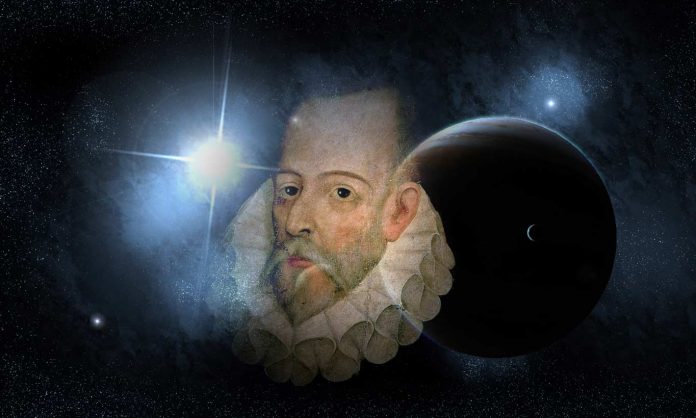
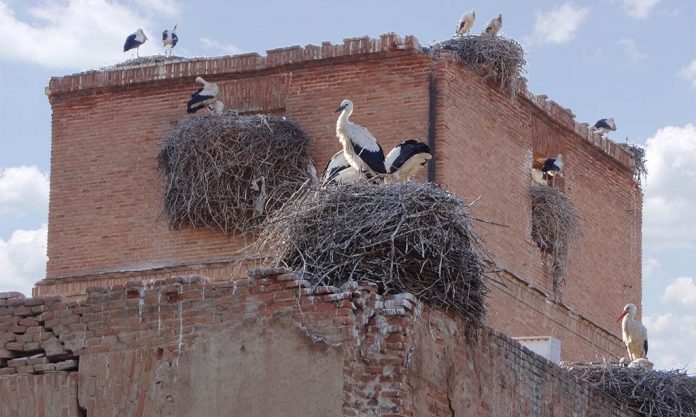

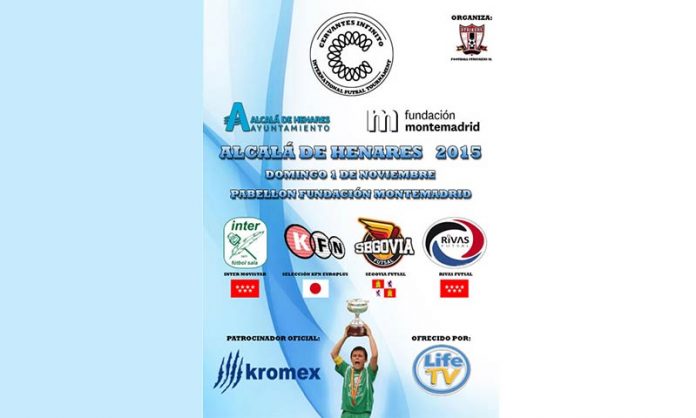
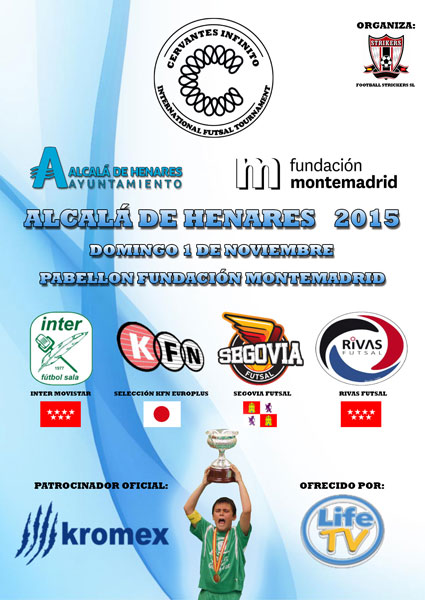
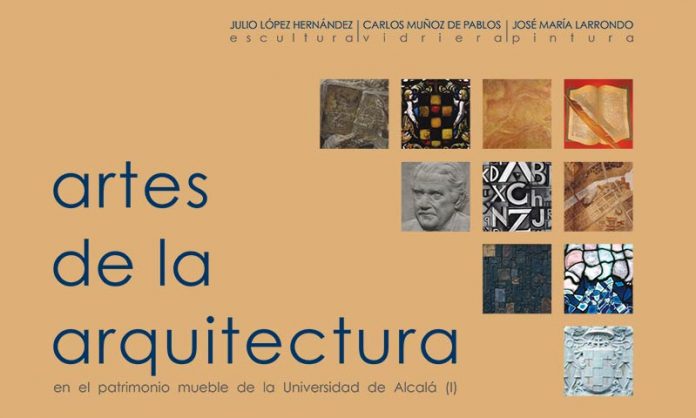
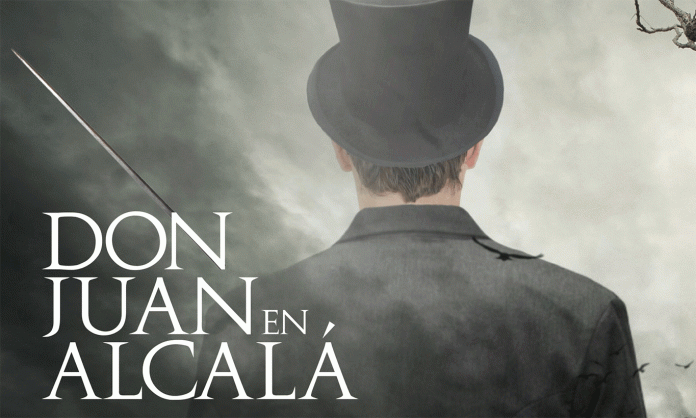

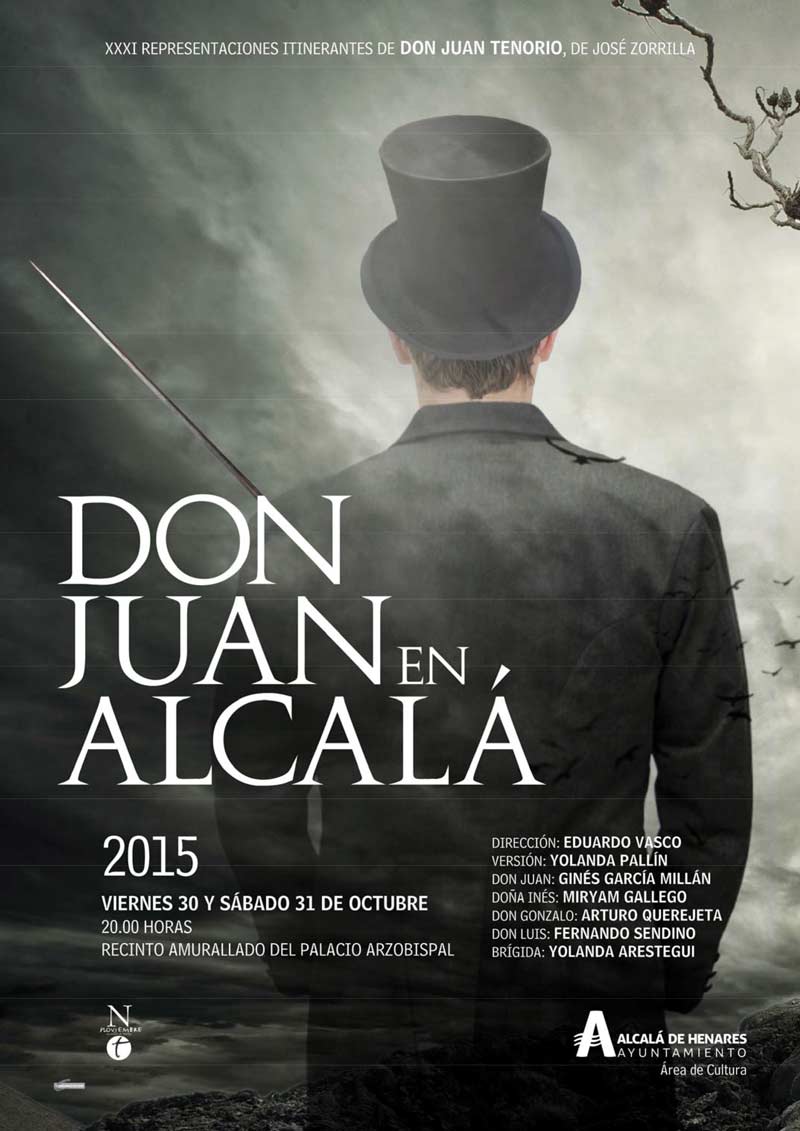

 GINÉS GARCÍA MILLÁN/ Don Juan
GINÉS GARCÍA MILLÁN/ Don Juan










